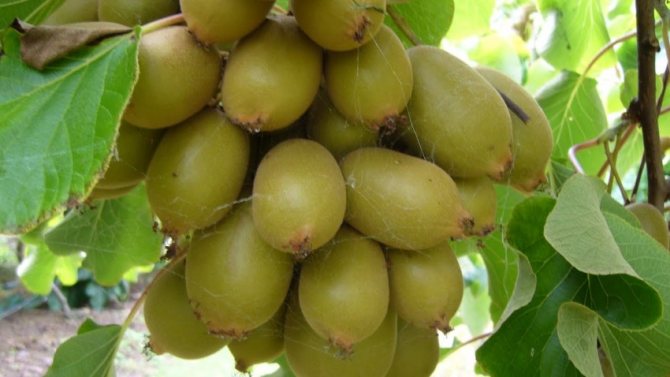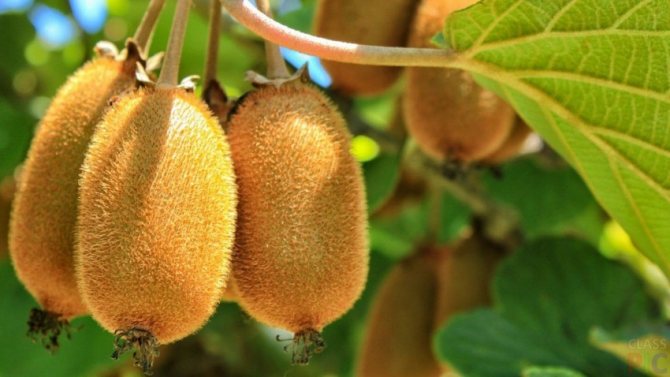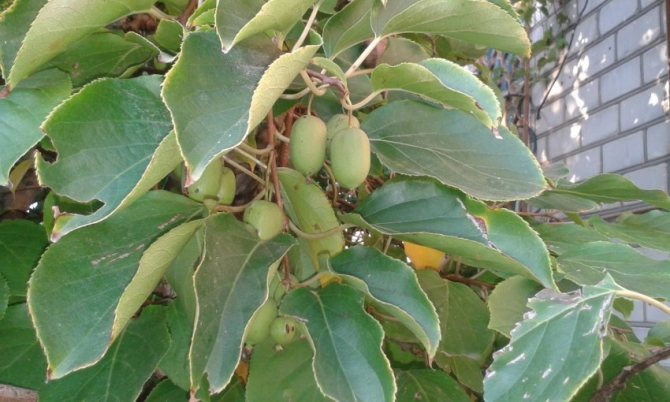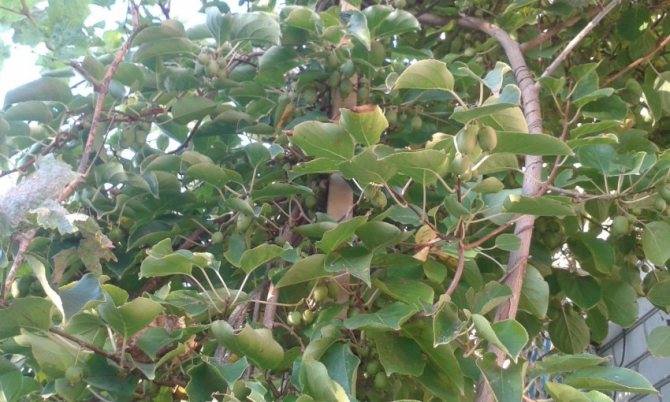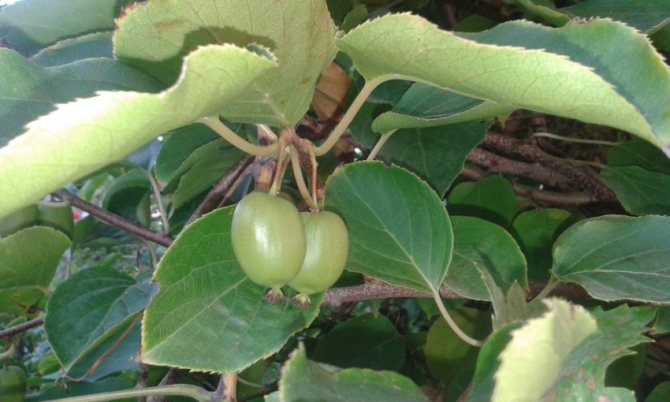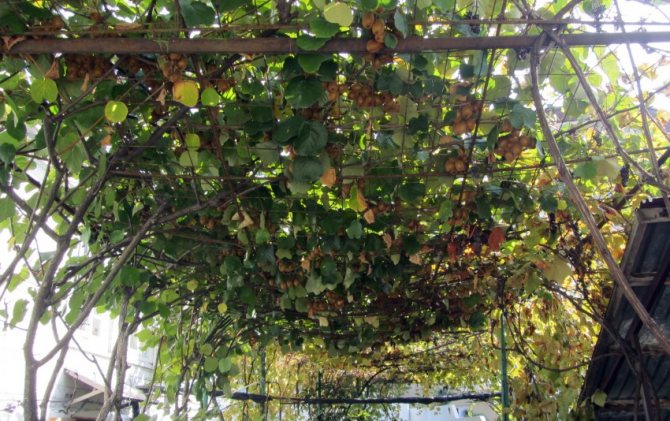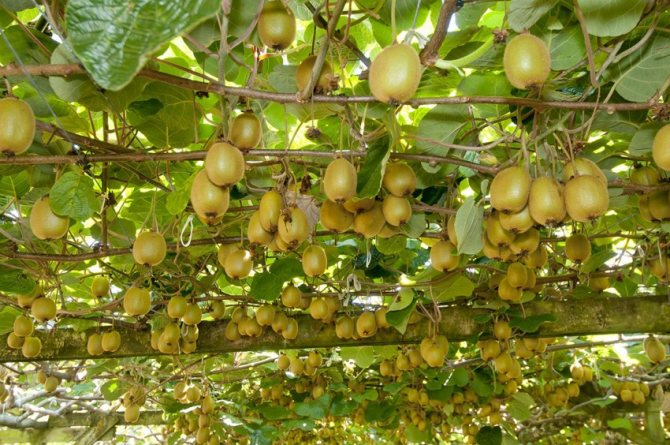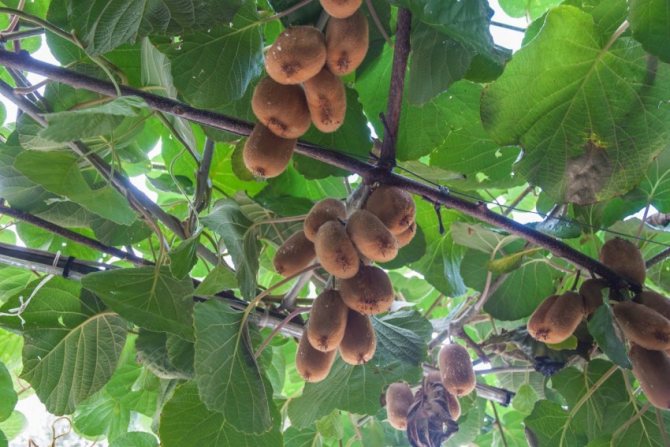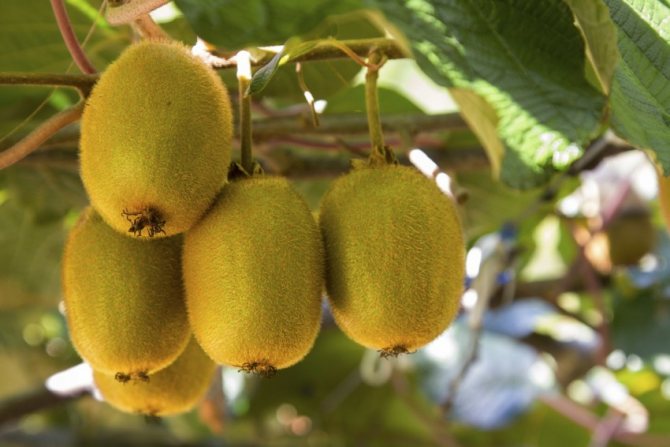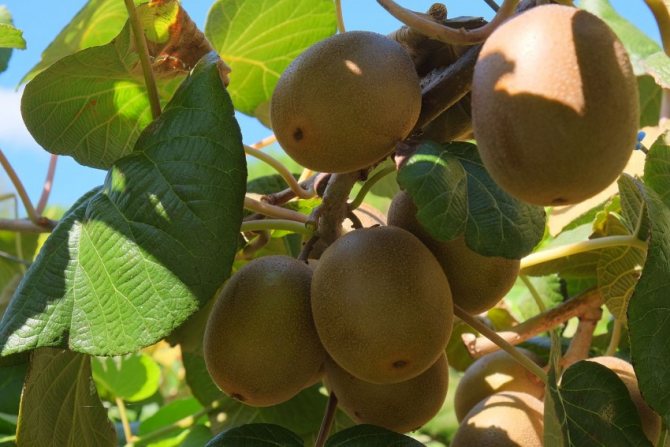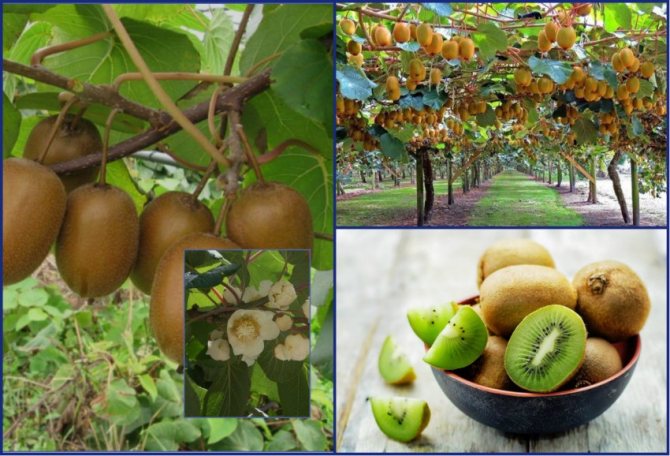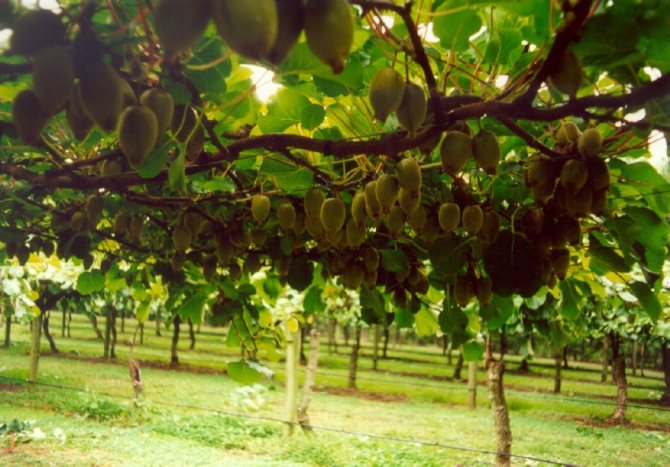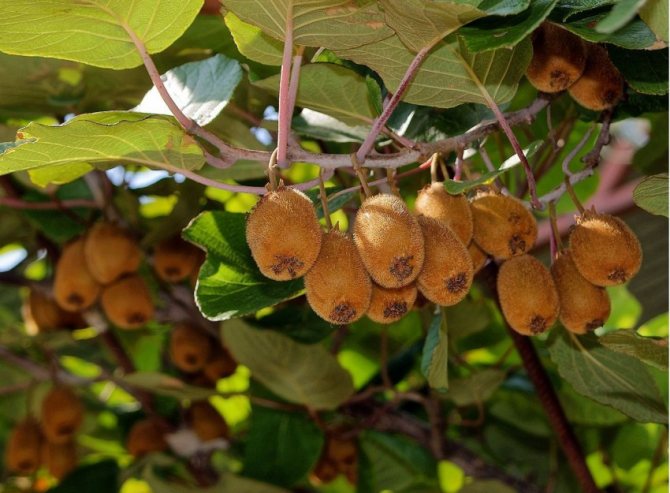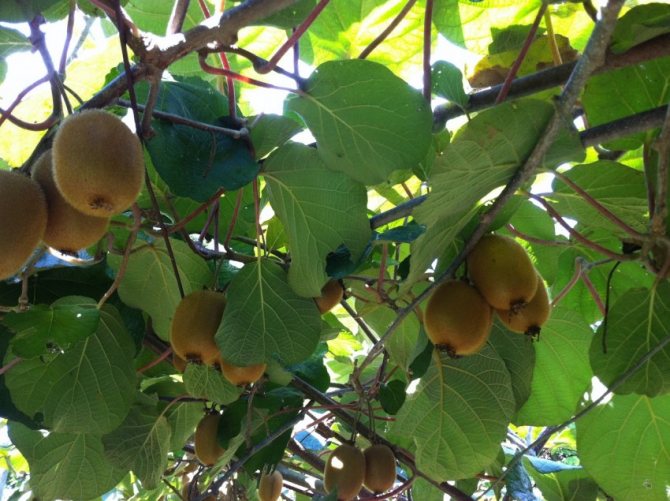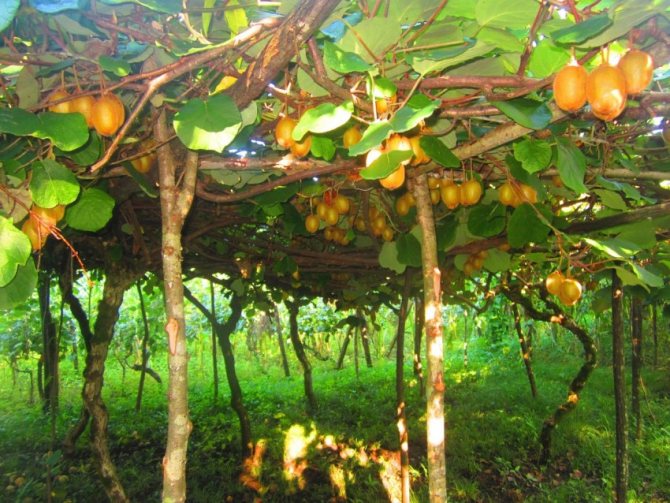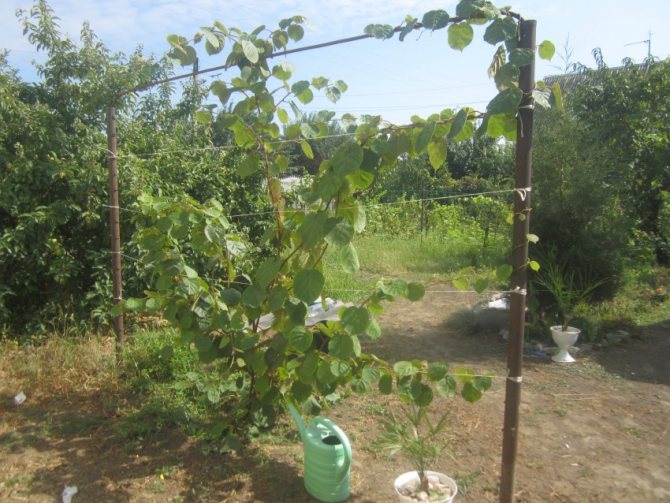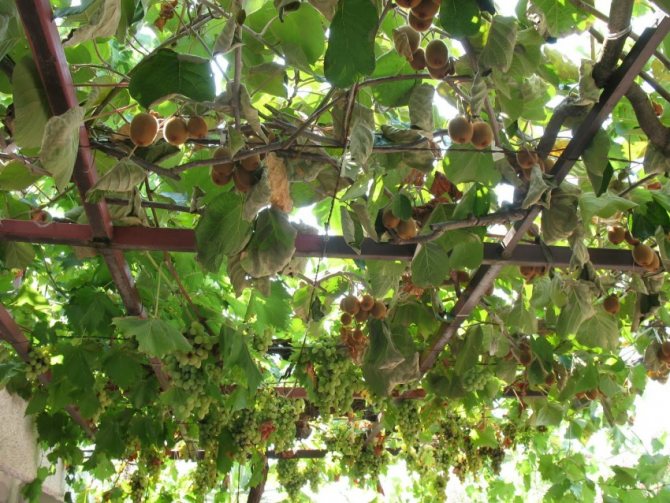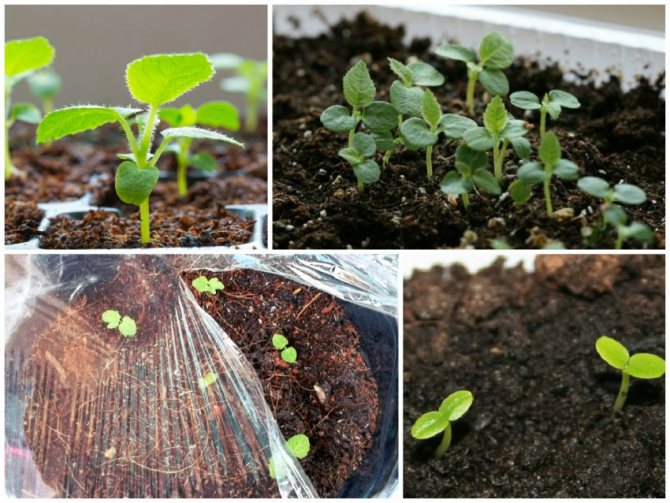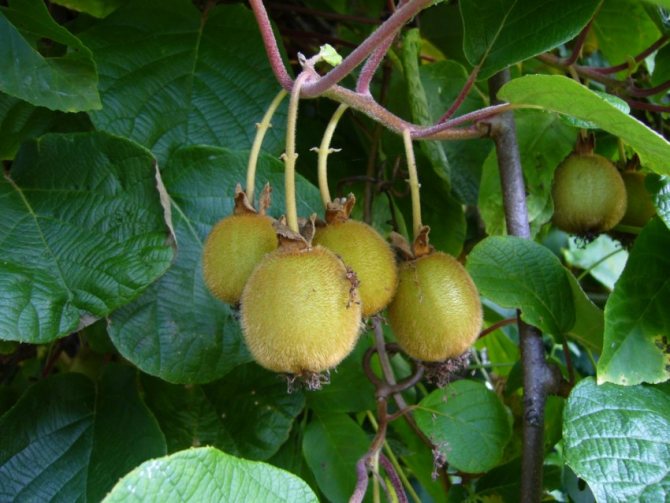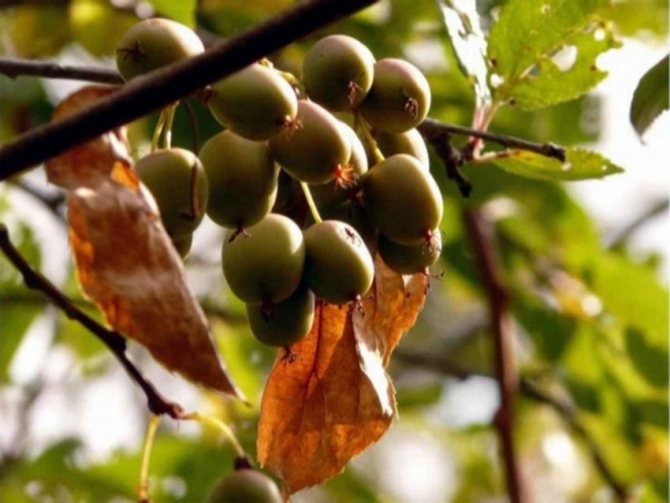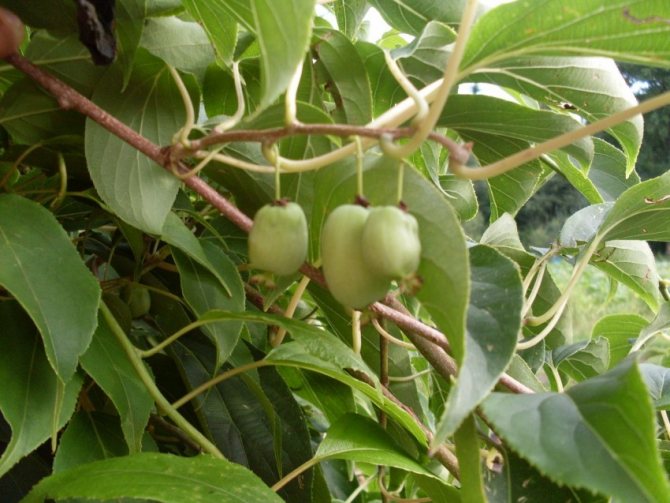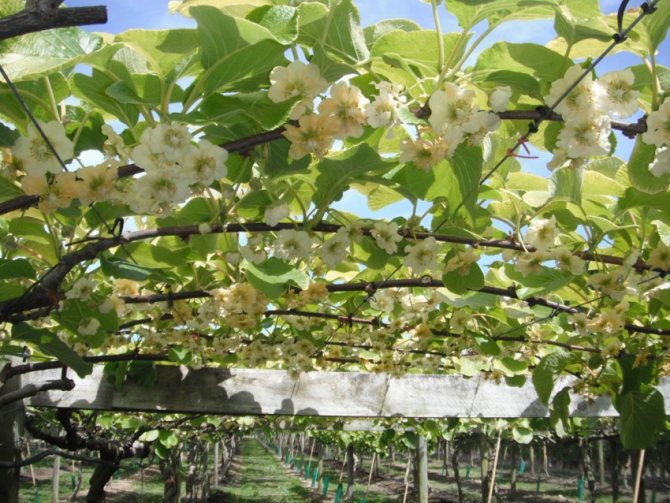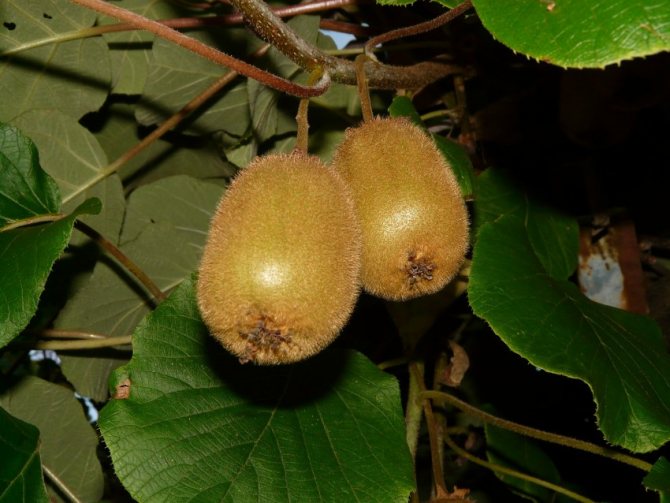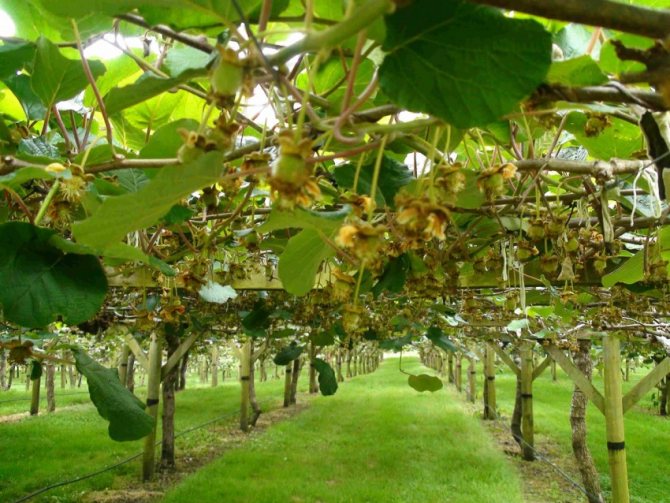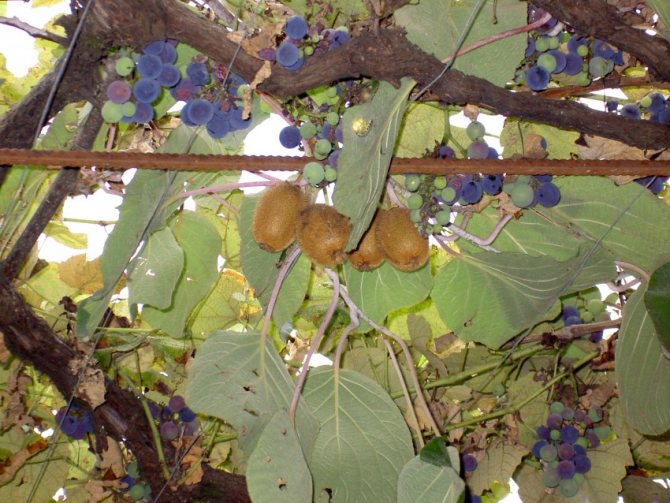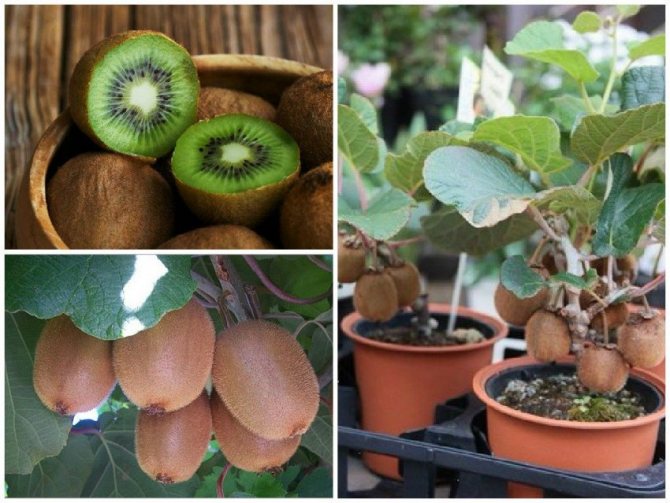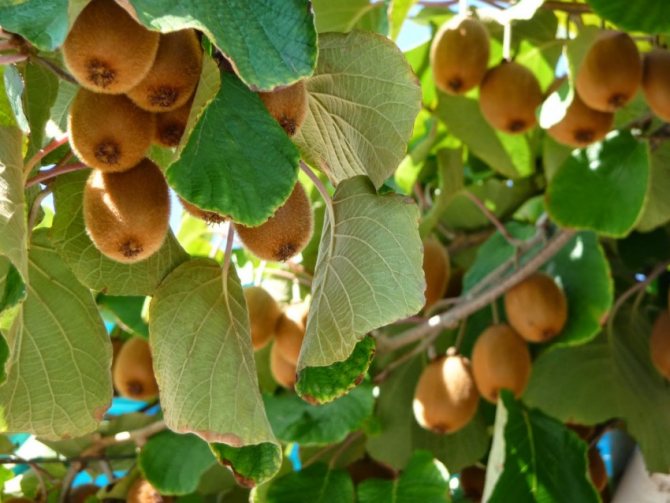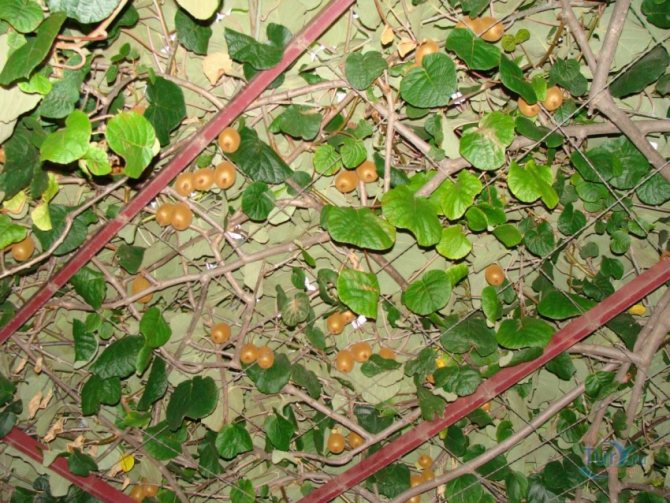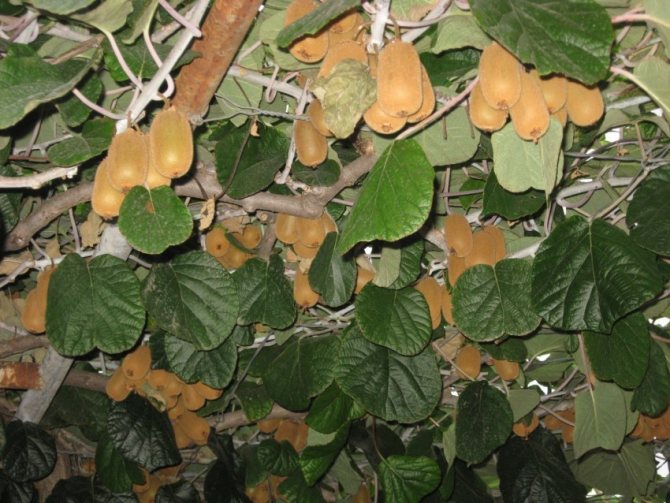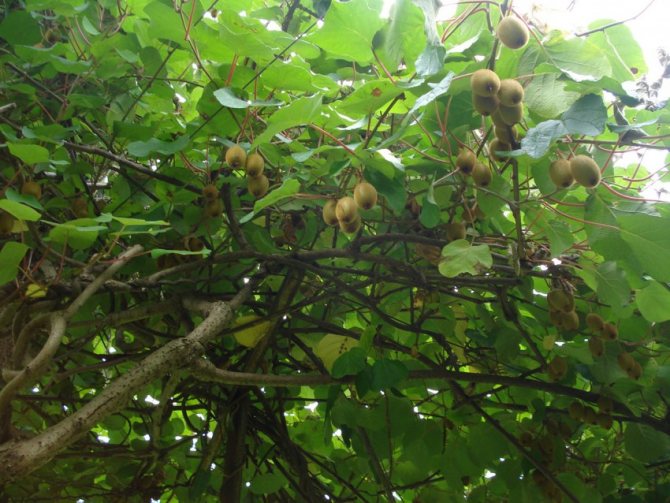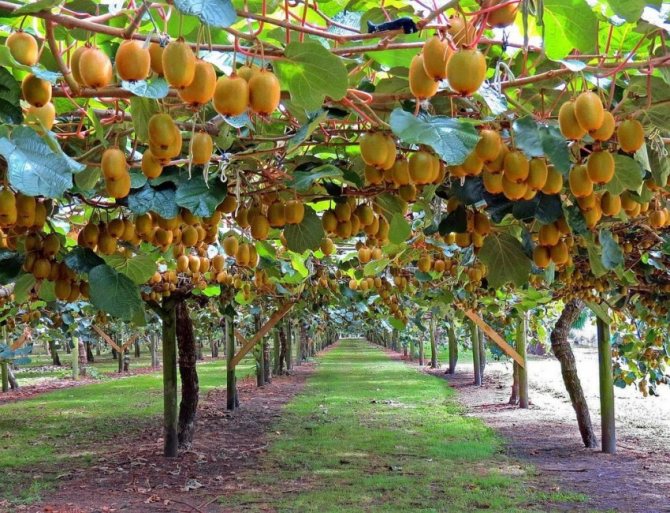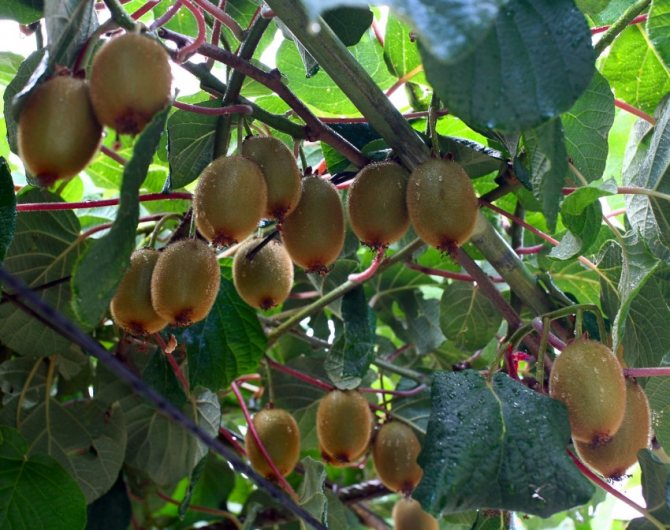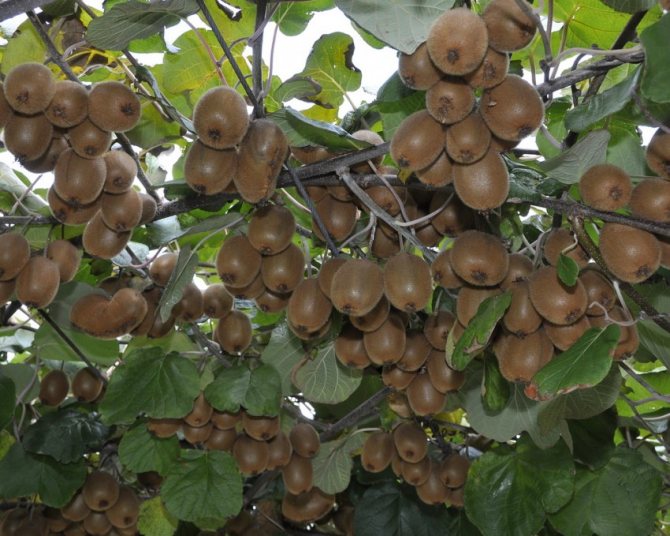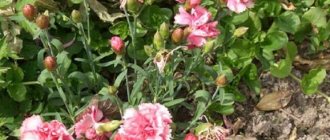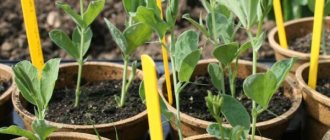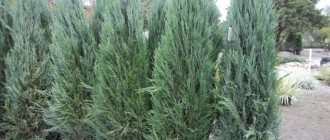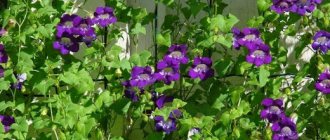A small oval fruit with a brown skin and bright green flesh is probably familiar to everyone. Kiwi is a tropical liana, on which fruits that are well known to all of us grow in bunches. Kiwi grows naturally in the humid climate of the subtropics. However, it is possible to grow kiwi on your own at home or outdoors.
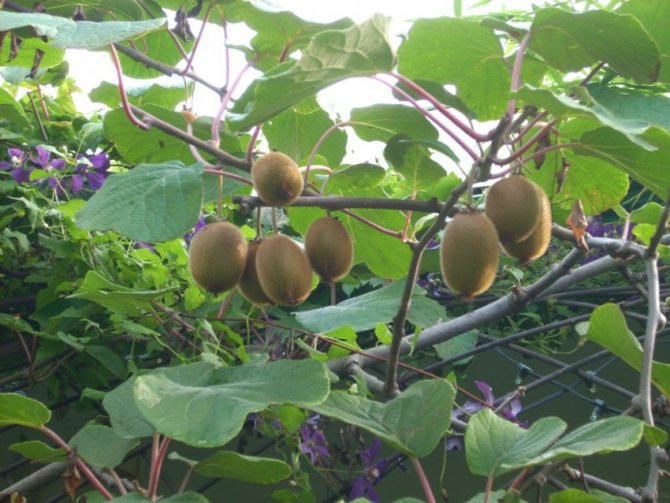
Kiwi is an unpretentious plant, and with proper care, anyone can try to grow it on their own. You will learn how to grow kiwi yourself in this article.


Kiwi - Chinese actinidia
Kiwi is the commercial name for the fruit of the Actinidia chinensis from the Actinidiaceae family. In the wild, this large woody liana with leaves falling for the winter grows in the subtropical forests of southern China. In nature, the vines of Chinese actinidia reach 10 meters in length, climbing high into the crowns of trees.
The large, wide leaves of the kiwi look very unusual and attractive. This vine gives a lot of shade, it is good for landscaping yard sheds, pergolas and gazebos in the southern zone.
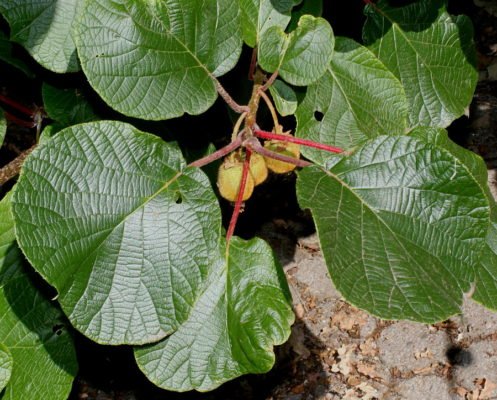

Kiwi is a deciduous vine with large leaves
Kiwi fruit is a juicy berry covered with a slightly hairy brownish skin, under which a delicious and aromatic pulp is hidden. The skin is rough and not used for food, only the pulp of the fruit is edible. The seeds of kiwi are very small and numerous, they are not felt when eating, so there is no need to remove them when peeling this fruit. Fruits are oval in shape, slightly larger than a chicken egg, weighing up to 100-150 grams.
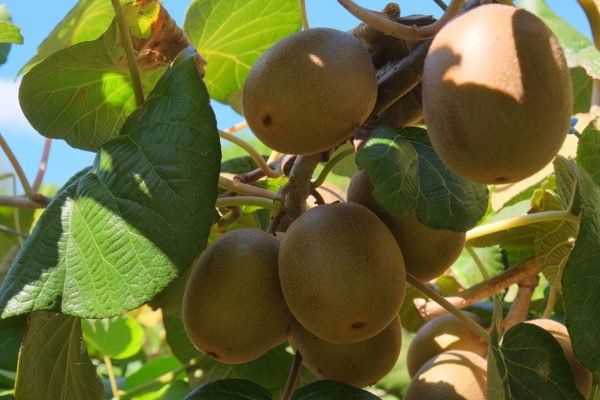

Kiwi fruits are slightly larger than a chicken egg
The flesh of kiwi fruit is a beautiful bright green color, in most varieties it remains green even when fully ripe, although recently varieties with yellow flesh have begun to appear. It is very easy to distinguish between a ripe fruit and an unripe one:
- unripe fruit is hard to the touch
- the ripe fruit becomes soft, and its pulp becomes transparent.
For long-term storage for many months and transportation over long distances, kiwi fruits are harvested slightly immature, while they are still firm. Fully ripe soft fruits are stored for only a few days, even in the refrigerator.
In order for the purchased hard kiwi fruits to ripen faster, they must be folded into a plastic bag along with several ripe apples, the bag must be tied up and left in the shade at room temperature for 3-5 days.
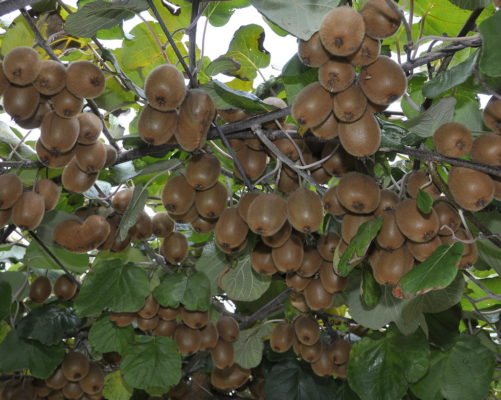

Kiwi is an important commercial fruit crop in subtropical countries
Actinidia Chinese has been cultivated since ancient times in the gardens of China and neighboring countries of Southeast Asia, where many local varieties have been created. But this fruit crop gained world commercial importance and international popularity only in the last century, when old Chinese varieties were brought to New Zealand. The outlandish oriental liana took root well on New Zealand soil, and local breeders managed to create varieties with especially large fruits, for the promotion of which the commercial name "kiwi" was invented (in honor of the unique flightless bird, which is a generally recognized symbol of New Zealand).
Modern large-fruited varieties of Chinese actinidia are often singled out as a separate species - gourmet actinidia, in order to distinguish them from their wild ancestors.
Large-fruited kiwi varieties
The main characteristics of large-fruited kiwi varieties (table)
| Name | Ripening period | Fruit size |
| Hayward | Late maturing | 80-150 g |
| Kivaldi | Late maturing | 75-100 g |
| Monty | Mid-season | 50-80 g |
| Abbot | Mid-season | 45-65 g |
| Bruno | Early ripe | 50–70 g |
| Allison | Early ripe | 40-60 g |
Regions of industrial culture kiwi
Currently, kiwi is the most important commercial fruit crop in New Zealand, in the subtropical zone of the United States and the countries of South America, in China, Japan, and in many countries of southern Europe.
A lot of kiwi fruits are now grown in Italy. I had a chance to talk with several Italian farmers, owners of such plantations. In their opinion, the kiwi culture is less troublesome and more profitable compared to the traditional grapes for those places: kiwi practically does not have pests and diseases, therefore labor-intensive treatments with pesticides are not needed at all, the harvest is guaranteed to be environmentally friendly and stored much longer. For planting kiwi, in the same way as for vineyards, you can use inconvenient areas in the foothills and on the slopes of the hills, and the construction of supports is not particularly different from grape ones.
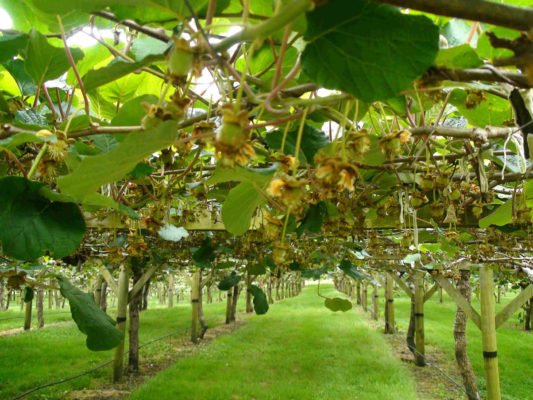

Kiwi plantations in many countries are successfully replacing vineyards
Kiwi grows well in the southern part of Russia: on the Black Sea coast of the Caucasus, in the Crimea, in the south of Dagestan. On the southern coast of Crimea, in Sochi and in Krasnodar, kiwi successfully winters without shelter; in more northern regions, vines must be removed from supports for the winter, laid on the ground and covered.
How kiwi grows in Yalta (video)
You can grow kiwi in the Black Sea regions of Ukraine. Successfully fruiting amateur plantings of this vine also exist in Transcarpathia. In Kiev, the Chinese actinidia sometimes bears fruit in some particularly successful years, but it freezes significantly in frosty winters. In Belarus and central Russia, growing kiwi is possible only in greenhouse conditions.
Photo of kiwi
What is Mini Kiwi
In recent years, many garden nurseries have used the name "mini kiwi" to increase consumer demand for seedlings of other types of actinidia:
- actinidia arguta,
- actinidia purpurea,
- actinidia kolomikta.
Compared to the Chinese actinidia, these species are much more winter-hardy, especially the actinidia kolomikta, which grows and bears fruit without any shelter, even in the Moscow region, Siberia and the Urals. In terms of size, their fruits are much smaller than that of kiwi, but they are in no way inferior to them in taste and in the content of nutrients.
Varieties of mini kiwi
In my garden on the Middle Volga, the liana of actinidia kolomikta has been bearing fruit for many years, annually at the end of August yielding medium-sized berries the size of a grape, with a taste and aroma like real store kiwi.
We sow
Sow the seeds in the following sequence:
- pour expanded clay on the bottom of the pot, in a layer of 3-4 cm;
- fill the container with soil and level;
- at a distance of 5 cm, make holes 5-10 mm deep and put 3 seeds in each;
- carefully cover the holes with soil. Water the plantings abundantly with warm water, cover with foil;
- place the pot on the south-facing window. This will provide the plants with the amount of light and heat necessary for their normal growth and development.
Lift the foil daily and spray the soil with water from a spray bottle. If you do not water, the earth will dry out, and the shoots will die.
How kiwi blooms and bears fruit
Kiwi, like all other types of actinidia, is a dioecious plant. Male and female flowers are located on different specimens. It becomes possible to reliably determine the sex of plants only during flowering.Lianas of seed origin usually bloom 5–7 years after sowing the seeds, grown from cuttings and cuttings a little earlier, already by 3–4 years.
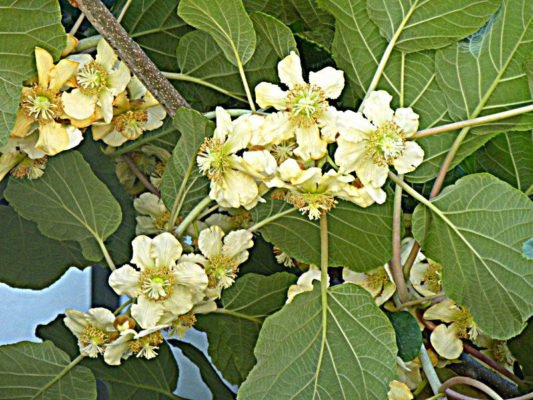

Female kiwi flowers are arranged in small groups
Female kiwi flowers are arranged in small groups. They are white or slightly creamy in color. In the center of each female flower, a large pistil with an asterisk-like stigma is clearly visible. The stamens surrounding it are underdeveloped, so self-pollination is impossible.
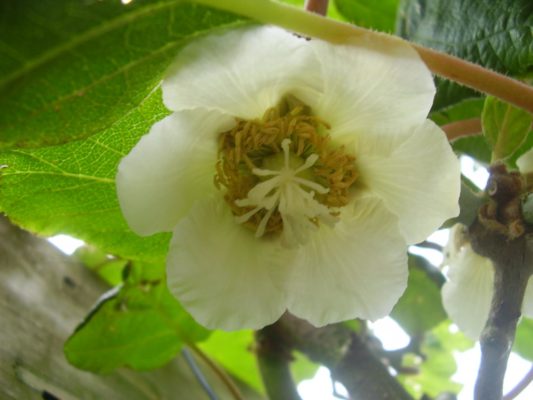

In the center of the female kiwi flower, the pistil is clearly visible, and the stamens are underdeveloped
If too many female flowers have formed and successfully pollinated on a plant at the same time, then the fruits that have grown from them will be small. To obtain especially large fruits, soon after the formation of ovaries, they are thinned out, removing the excess ones.
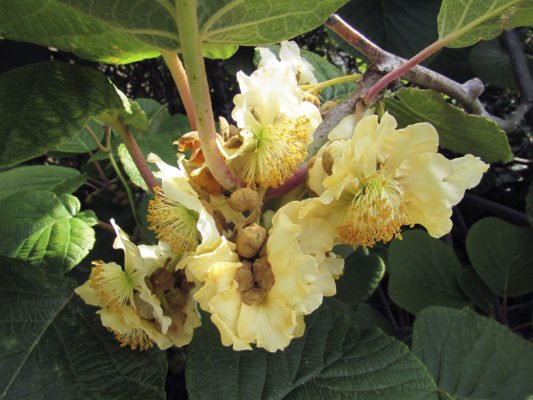

Male kiwi flowers do not form fruit, but are necessary for pollination
Vine formation
Only the annual transplant and crown formation will require special attention. The fact is that in nature, the braiding trunk of actinidia grows up to 7 - 9 m, sometimes it is longer. Keeping a vine of this size at home is, of course, not convenient. Therefore, at home, it needs to be cut, starting from a young age, to form the trunk at your own discretion.
You need to leave the first 5 buds on the stem, since they are the ones that bear fruit. And one more thing - you have to take care of a supporting support, about 2 m high. Actinidia, used in parks as ornamental plants, are especially good during flowering, they may well be a decoration of the house. The vine grows strongly, even if you have to wait a long time for fruiting (sometimes up to 6 years), but on the windowsill it looks very attractive.
Features of growing kiwi in the open field
When planting kiwi, for every 10 plants of female fruit-bearing varieties (Hayward, Kivaldi, Monty, Bruno, Abbot, Allison, ...) for pollination, at least 2 plants of male pollinating varieties (Matua, Tomuri,…) must be planted. The distance between seedlings when planting is at least 2-3 meters.
To grow kiwi, you need a support. Trellis are usually installed before planting seedlings. The height of the trellises is 2–2.5 meters; to tie the shoots between the posts, a strong wire is stretched horizontally in 1–3 rows. Formative pruning is carried out in late autumn after harvest, cutting thickening, weak and too old shoots.
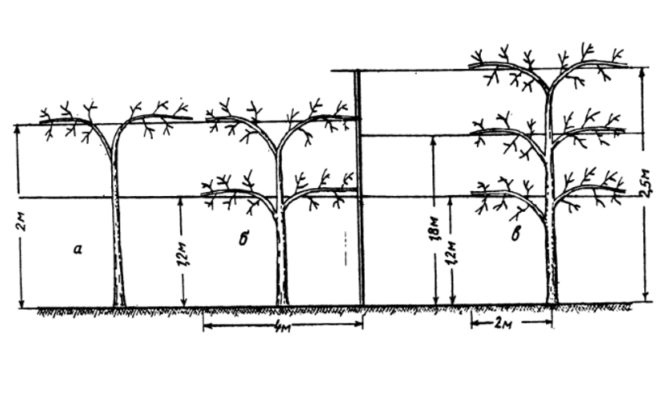

To grow kiwi, they arrange trellises from pillars and a wire stretched between them.
Actinidia chinensis needs high humidity in the air and soil, so the plantations are regularly watered. In small backyard gardens, plants can be planted in light partial shade to protect from the scorching southern sun. It is convenient to plant kiwi near a gazebo or an open veranda, you get a beautiful shady canopy of green leaves.
Without shelter, adult kiwi plants withstand short-term frosts down to -15 ..- 17 ° C, young specimens are severely damaged already at -10 ° C.
In regions with possible winter frosts, for better wintering, kiwi vines can be additionally covered for the winter:
- Cover the ground near the plants with spruce branches or plastic so that the vine cannot rot from contact with the soil.
- Remove the vine from the supports and lay it on the floor.
- Cover the top with spruce branches or reed mats.
- Cover the top of the insulating material with plastic wrap, fix its edges with bricks or sprinkle it with earth.
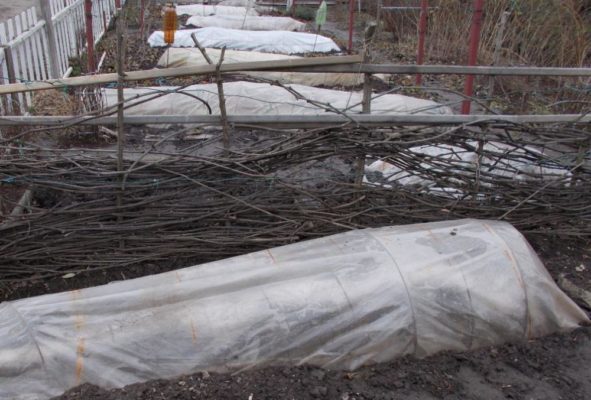

To protect against frost, kiwi can be covered for the winter
In the event of strong prolonged thaws, the shelter must be ventilated. In the spring, the shelter is removed and the vines are tied to a trellis.
Landing in the soil
There is nothing difficult in disembarking a kiwi. But there are some rules that are very important for every gardener to follow:
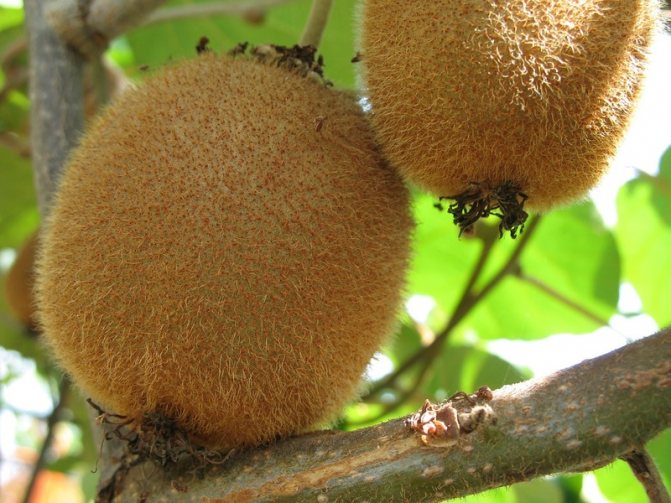

Since the kiwi vine grows and develops quickly, and the purchase of pots for indoor plants for growth is not recommended, then a young plant needs to be transplanted quite often, every six months. For the first few weeks after the dive, the culture should be rearranged from the windowsill to a place where direct sunlight will not fall on it. For adult plants, high temperatures are not terrible, but young seedlings from such an effect can impair growth and stop development.
A plant transplant is carried out if necessary. Most often, gardeners carry out transplants every few years. In this case, the diameter of the pot is increased by five centimeters. When planting, it is important to damage the clod of earth and the root system of the culture as little as possible.
Growing kiwi at home
If you wish, you can try to grow kiwi as a houseplant, although there is no particular point in this:
- fruiting requires the presence of male and female specimens blooming at the same time (pollination is carried out manually with a soft brush);
- kiwi is a large vine that takes up a lot of space;
- for the formation of flower buds, a cool wintering with a temperature of about + 5 ° C is necessary;
- flowering occurs late, 5–7 years after sowing the seeds, and it is possible to determine the sex of the seedlings only during flowering.
For sowing, you can use seeds from store-bought kiwi fruits:
- Withstand the fruits in a warm room until fully ripe (should become soft, with transparent flesh).
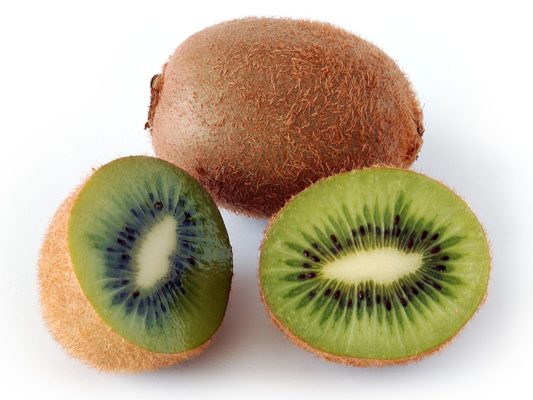

Seeds from ripe kiwi fruit can be used for sowing
Caring for indoor kiwi consists in regular watering with settled water, preventing the soil from drying out in a pot (watering more often in summer, less often in winter), weekly spraying the leaves with lukewarm water from a spray bottle and an annual spring transplant. To tie the curly shoots in a pot, a frame made of thick insulated wire is fixed.
How to grow kiwi at home (video)
When to plant and how to choose kiwi for seeds
Almost all kiwi varieties grow and develop well in indoor conditions. But from my experience I will say that high-yielding and early-growing Highward, Abbott, Bruno are best suited for growing at home. The optimal time for sowing seeds to obtain highly productive seedlings is from March to May. It is during this period that the highest seed germination is observed.
When choosing kiwi for seeds in the store, give preference to fully ripe fruit. It should be soft, even, without obvious defects and mechanical damage.
When you get home, wash the fruit thoroughly and cut it in two. Gently peel off one half. Mash the pulp with a fork and send it to a glass or mug with warm water to settle. After 10-15 minutes, rinse the contents of the glass several times - the pulp will disappear, and the seeds will remain floating on the surface.
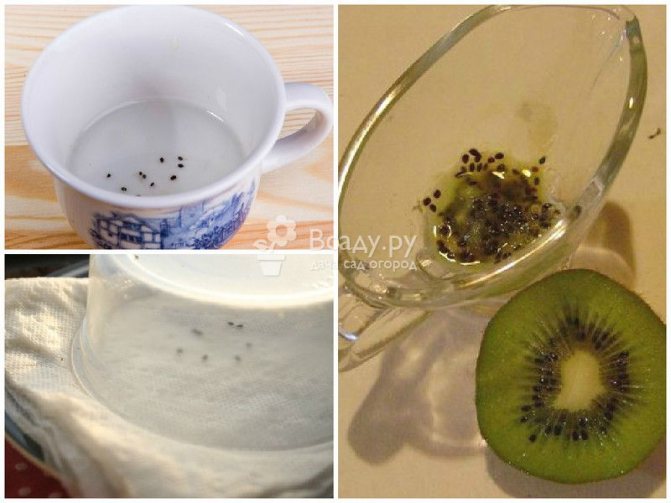

How to get seeds from kiwi fruit properly
Remove the washed bones from the water, put them on paper. Then leave in a dry warm place for 2-4 hours, until completely dry. After this time, wrap the seeds in a damp cloth and place on a saucer. Cover the plate with plastic wrap and send it to a warm place for one week. Thus, you will create a mini greenhouse for seed germination.
The best time to start growing this plant is March - May. Taking into account the waste in the growth process, it is recommended to plant about two dozen seeds. Ripe kiwi fruits, the seeds of which are ready for sowing, are soft, their ripeness can be determined by the delicate, specific taste and aroma of the pulp. In most varieties, it retains its green color even when mature.
There are many seeds in the fruit - from one to almost one and a half thousand, they are very small, black, located around the core.They can be completely separated by washing, and it should be done very carefully so that the bones do not rot in the soil. This can be done on a fine mesh strainer under running water, in gauze, or just in a glass.
The seeds washed from the pulp are dried and placed in a kind of greenhouse for germination. Moisten a piece of cloth with warm water, put it on a saucer, place the seeds, cover with a plastic lid or glass to reduce evaporation. The greenhouse is kept in a warm (more than 20 ° C) place, constantly keeping the fabric moist. The bones will hatch in 7-10 days, very small white roots will appear.
The growing process includes several stages, each of which is important and can affect the yield of the plant.
To extract the seeds from the fruit, choose a fresh kiwi that is well ripe.
The process includes the following steps:
- the pulp of the fruit must be kneaded with a fork;
- move the resulting gruel into a gauze bag, which should first be folded into 2-3 layers;
- rinse the bag until the pulp is completely removed;
- the seeds that remain in the gauze must be removed and laid out on a paper sheet; the leaf is left at room temperature so that the seeds dry out properly, make sure that direct sunlight does not fall on them.
After the extraction of seeds, they begin to stratify them. To do this, the planting material must be mixed with sand, placed in a resealable container and left in the refrigerator in the vegetable compartment for 2-3 months.
During this period, it is important to ensure that the sand is always moist, and it is worth ventilating the container from time to time. After the "artificial winter" is completed, the planting material can be used for sowing activities.
Before sowing seeds, you need to germinate them. Put a cotton pad on a saucer, which is pre-moistened with hot water. Seeds are spread on it in an even layer.
In order for the seeds to germinate, greenhouse conditions must be created. It is necessary to cover the plate with polyethylene, and at night you need to take it off, and put it back on in the morning, pouring a little water on a cotton pad. After about 2 weeks, the seeds will germinate - this indicates their readiness for planting in the ground.
Soil preparation
For planting seeds, you should choose medium-sized pots. Light fertile soil with low acidity is ideal for kiwi. The soil can be purchased in specialized stores or prepared by yourself.
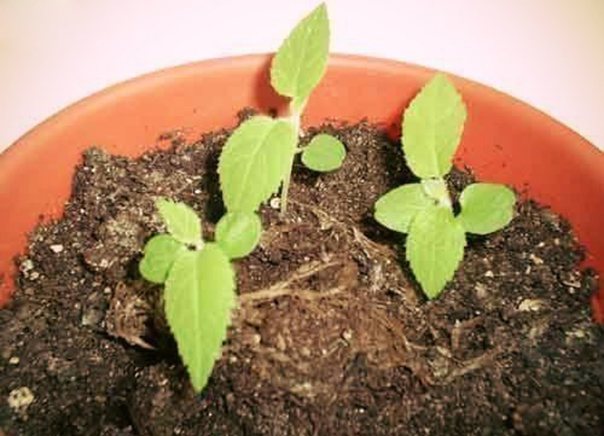

To do this, in equal proportions, you need to mix humus, sand, peat, leaf and turf soil. Before proceeding with planting, the mixture must be heat treated.
The planting process includes the following steps:
- A drainage layer is laid at the bottom.
- Prepared soil mixture is poured on top of the drainage.
- Holes are made in the soil, the depth of which is no more than 5 mm.
- Planting material is laid out in the holes, covered with a thin layer of soil and slightly moistened.
- The pot or container is covered with plastic wrap, placed in a warm and bright room.
Did you know? In 1992, a new variety of kiwi was introduced in New Zealand. It is distinguished by its unusual golden pulp color and high cost.
Every day, the shelter must be removed and the plantings must be ventilated and watered.
After 4 weeks, several leaves will appear on the sprout. It was during this period that picking is carried out - planting seedlings in separate small pots. Kiwi has a very delicate superficial root system, so it is worth carefully removing the seedlings from the common container.
If the roots are damaged, the plant may die.
When transplanting kiwi fruit into pots, it is very important to add some compost to the prepared potting mixture.Further feeding should be carried out from March to September every 2 weeks.
Mineral fertilizers are ideal for this.
Kiwi is a moisture-loving plant, and it is very important not to allow the soil to dry out.
It should always be damp, but overflows can cause the roots to rot. Choose pots that have drainage holes to allow excess water to drain out of the soil.
Be sure to ensure that the water does not stagnate in the sump. During the hot period, it is recommended to spray the plant daily.
To obtain a harvest, in addition to ensuring the proper level of illumination, regular moisture and proper feeding, it is necessary to carry out other measures.
It is imperative to make supports. They are needed so that the vine can climb up. To improve branching, it is necessary to regularly pinch the plants.
Do not forget that cross-pollination of male and female flowers is necessary to obtain a harvest. Provided it is carried out, the first fruits can be harvested 6-7 years after planting.
Testimonials
Kiwi is a perennial plant that requires a cool wintering.
Odina
Kiwi begins to freeze even at minus 10.
Marusya
I cover as well as grapes ... I did not notice the difference in winter hardiness of grapes and kiwi. The only negative is that kiwi wakes up a little earlier than grapes, which means that the probability of getting frozen is much higher.
Alexey Sh
Actinidia Chinese - this is the real kiwi! In the Kiev Botanical, it grows, and even sometimes bears fruit
Sveta2609
Kiwi is a very promising fruit crop for regions with a mild subtropical climate. In a slightly more northern regions, like the Chernozem region, shelter for the winter will help protect the vines from frost. And in central Russia, where kiwi does not hibernate even under careful shelter, other types of actinidia with high winter hardiness and slightly smaller than that of real kiwi, but no less tasty and healthy fruits, grow beautifully.
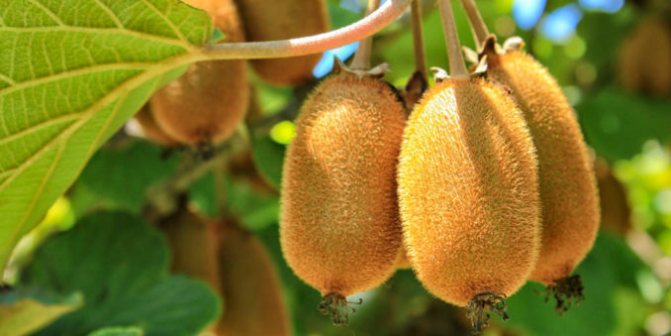

Kiwi or Chinese actinidia is a tree-like tropical liana, its habitat is located in the subtropics of Italy, Abkhazia, New Zealand, Chile and the Black Sea coast. This wild fruit first appeared in New Zealand in the early twentieth century. Later, a large-fruited variety of actinidia was bred. But few people know how kiwi grows in nature and at home. Therefore, this information will be useful for those who want to grow this plant at home.
Wintering
Since kiwi is still a tropical plant, for its successful wintering, you need to create the safest conditions possible. Gardeners advise mulching vines at least 10 cm in height. After that, you can lower the vines a little to the ground, and build a kind of hut for them (best made of wood), and wrap the entire structure from above with several layers of polyethylene. This will protect the plant from both frost and snow. Only the weakest young shoots can freeze, which is completely uncritical. It is also advisable to open the "hut" little by little after the first warming so that the vines do not wake up ahead of time.
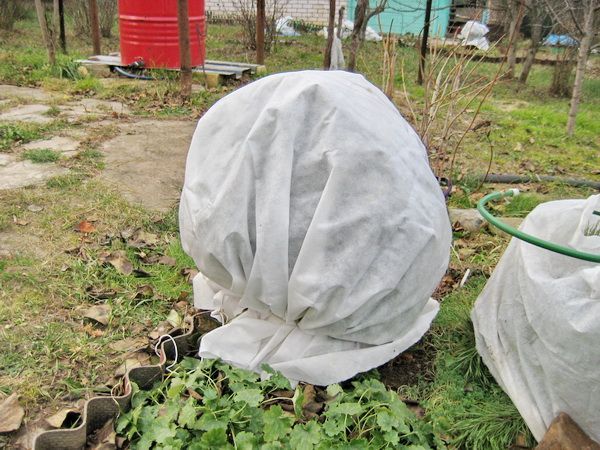

You can grow kiwi on your own in the open field, but it will be much easier to grow it at home. A stable temperature is very important for the plant, although many modern varieties of this fruit are not afraid of frost. The most important life factors for kiwis are good soil, abundant regular watering, and proper pruning.
Description of the kiwi plant and its fruits
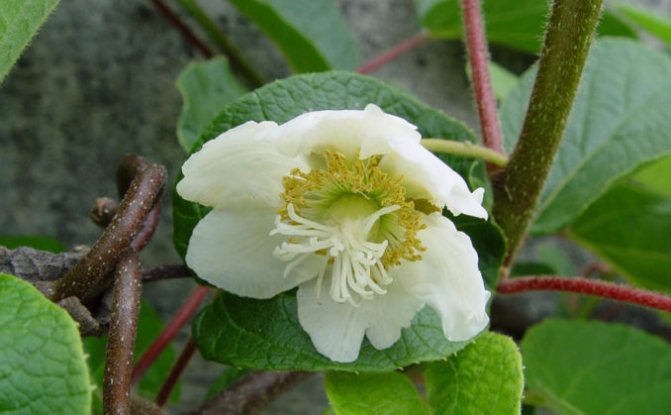

In appearance, kiwi by its appearance resembles a tree that requires support. In their natural environment, kiwi fruits, collected in bunches, ripen at the top of the shoots. Throughout the season, the tropical liana changes the color of the leaves from green to white, pink and crimson.This plant is popularly called the Chinese gooseberry. The ripe fruit is covered with a thin skin and has an amazing taste. Inside the fruit is a green, sweetish-sour pulp with numerous small black seeds. Most gourmets associate the taste of this fruit with strawberries, gooseberries, melons, apples or bananas. The average weight of one fruit is 80 grams. Kiwi fruits are rich in vitamin C, which is higher in fruits than in currants and lemons, and the content of a vital trace element, potassium, is twice as high as in the same bananas.
Useful properties of kiwi
Kiwi contains many minerals and vitamins. Even citrus fruits contain less vitamin C than kiwi. Kiwi also contains unsaturated acids, antioxidants and disaccharides.
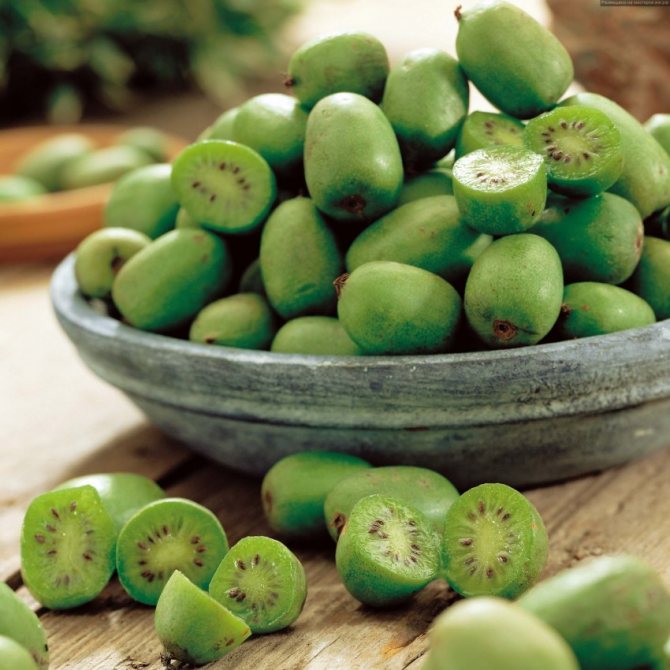

Kiwi, thanks to its beneficial properties, increases resistance to stress and helps to cope with fatigue. In addition, nutritionists advise kiwi for people who want to lose weight, so a variety of diets have been developed on its basis.
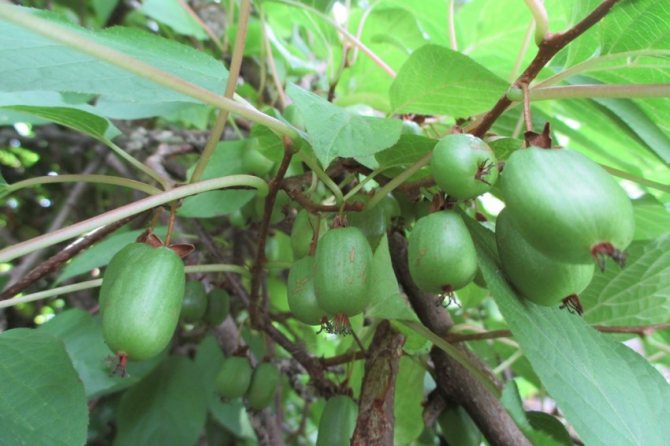

Can you get kiwi fruits at home?
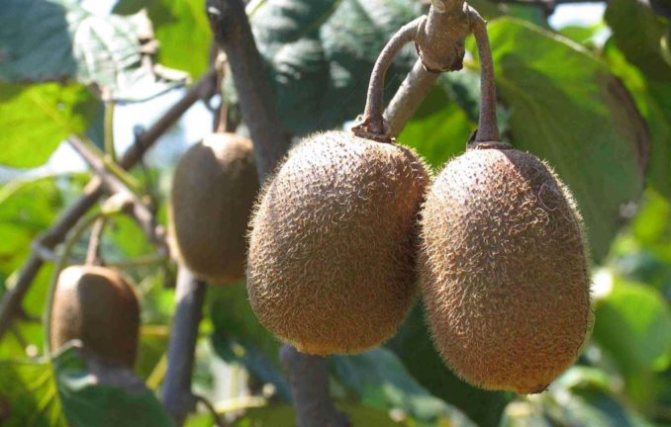

Growing kiwi at home is a completely real, fun and cost-effective process. In order to get the seeds, you need to purchase the ripe fruit at any grocery store. Currently, there are several varieties of this plant, and each of them can be grown quite successfully at home.
Given the natural growing conditions, kiwi is a sun-loving plant. He needs a certain place of detention on the windowsill on the south side, where there is no cold and drafts.
The technology for growing kiwi at home consists of several stages:
- Presowing preparation and germination of seeds.
- Seedling picking.
- Plant care.
Saplings and cuttings - kiwi propagation
Seedlings from seeds are germinated in the same way as described above, with the only difference that the seeds are sown in winter in January.
After a couple of years, any selected kiwi variety can be grafted onto a mature seedling.
Grafting methods:
• Into the cleft with hardened cuttings.
• In the cleft with a green handle.
• Budding.
At home, it is necessary to pick up a large container for kiwi so that the root system can grow and develop freely.
You can also start growing seedlings from rooted cuttings. This is especially suitable for hardened or green cuttings of this plant. A seedling or stalk is well adapted to frost and cold weather, so they can be planted directly in open ground.
Matured kiwi is a mighty vine that grows well. This must be remembered when choosing a place for a pot with a plant. After a while, the kiwi will have to be removed from the windowsill and installed in a more spacious place. And for the kiwi, you will need to make a strong support.
Closer to winter, the vine will begin to shed its leaves. During wintering, the plant should be in a bright room, where the air temperature reaches at least + 10 degrees. Water the plant at this time less often than always. With the onset of spring, the plant again begins to overgrow with leaves. At this time, you need to start cutting the vine and remove sick and weak shoots from it.
It is better to replant the vine every spring.
Liana needs to be provided with constant watering, feeding with fertilizers in a warm and bright room.
Germinating Kiwi Seeds
Seeds extracted from a ripe fruit must be washed well to remove pulp residues. Keep in mind that kiwi seeds are very small, they are washed through a sieve or cheesecloth. The cleaned planting material is dipped in a glass of water at room temperature and placed in a warm place, on the south side.
After 8-10 days, the seeds must open. If this does not happen, it is necessary to replace the water in order to prevent decay of the planting material. The opened seeds need to be provided with greenhouse conditions with systematic ventilation.
Preparing the soil
The next stage of growing kiwi from seeds is the purchase of planting containers and soil. It is better to take a long pot - this will make it easier to care for young plants. The soil can be prepared independently from peat, humus, sand and turf in equal proportions, or you can buy it in a specialized store, as I did. In any case, the soil mixture must be disinfected - kept in a water bath for two hours.
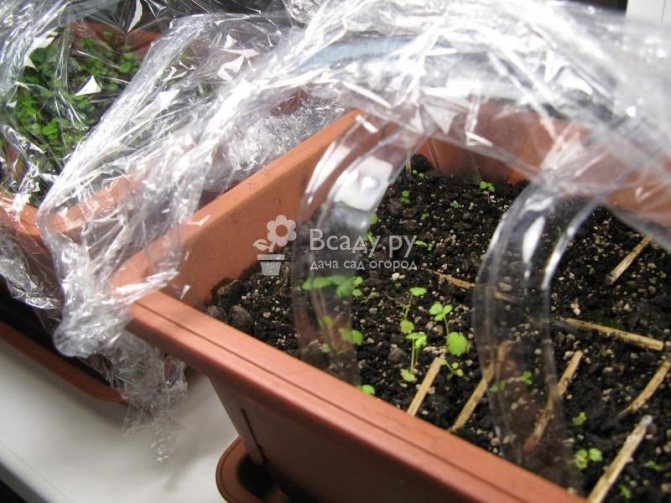

Sowing kiwi seeds in flower pots
Kiwi seedling care
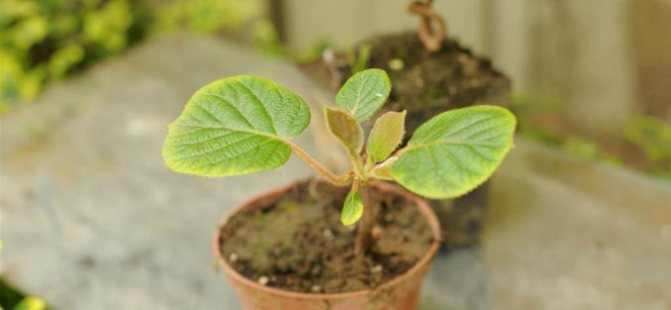

Sprouted shoots are spread on the surface of the nutrient substrate and sprinkled with a thin layer of earth - from 2x to 3 mm. The plantings are placed in a warm place and irrigated daily with warm water from a spray bottle. Spraying with water can be replaced by building a mini greenhouse made of transparent material. Condensation collecting under the film will create the necessary moisture for the seedlings.
After the shoots appear, the shelter is removed. As soon as the seedlings grow up and release one pair of leaves, they dive into other planting containers of a slightly larger size. By this time, the plant reaches 10-12 cm in height. In this case, the same soil mixture is used as for sowing seeds, only with a smaller amount of peat. Unpromising and unnecessary sprouts must be discarded immediately, selecting only the strongest and healthiest. Timely picking is extremely important, since the further development and fruiting of a tropical vine will depend on it.
Grafting a cutting
Most often, kiwi grown from seeds are used not for fruit production, but for rootstock for cultivars. For this, you can only use seedlings that are more than three years old. It is allowed to inoculate kiwi by any method, in each case the plant will give quite high results.
A lignified stalk is a part of a one-year shoot cut from an adult crop in winter. For culture, it is imperative to carry out such pruning. Green cuttings are obtained by cutting the tops of the shoots in the summer season.
The length of the cutting should vary from 8 to 12 centimeters with three pairs of leaves, the thickness of the shoot from which the cutting is cut is about 10 millimeters. In this case, the cutting should be completely healthy, the bark should be smooth and elastic. The best time to cut a cutting in summer is early morning.
To get a stalk, use a well-sharpened knife, scissors or pruner. It is best to use pruning shears in this case, since it minimally damages the structure of the shoot, the bark after it does not crack.
Kiwi plant care
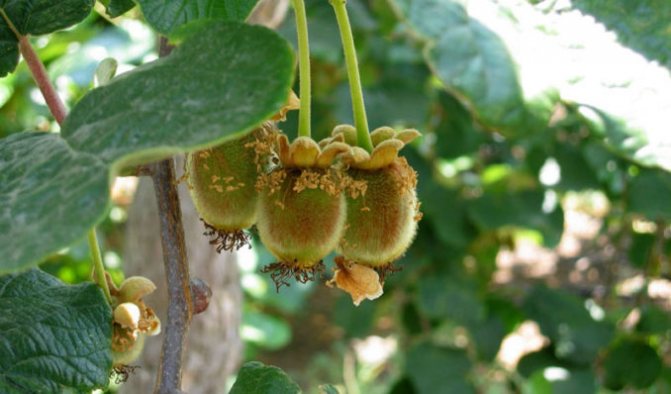

In order to ensure the full and active growth of plants at home, they need special care. For kiwi, it is necessary to create conditions close to the natural growing environment:
- First of all, these are frequent and moderate watering. This fruit does not tolerate drought, as well as excess moisture. Therefore, in order to avoid such consequences, kiwi is irrigated from a spray bottle. In the winter season, the exotic fruit stops growing, so its watering is reduced to a minimum - no more than three times a month. During the period of active growth, the plants are moistened more often - 2-3 times a week. On hot summer days, the kiwi needs frequent irrigation of the aboveground part.
- This fruit, like other exotic plants, grows actively in good and long daylight conditions. In addition, he needs warmth. Therefore, plants are placed on windowsills from the southwest or south side. If this is not possible, you can replace natural lighting with artificial lighting lamps.
- In order for the plants to fully develop, they must be periodically thinned out. At an early stage, young shoots are simply not pulled out. It will be more difficult to extract grown plants from the soil, since kiwi very quickly and actively builds up the root system.Weaker plants, thickening the plantings, are sheared.
- You can get healthy, fruiting plants with good nutrition. Kiwi is fed with compost or vermicompost once a year.
A shallow trench is dug around the plant and fertilizer is placed in it. During watering, the fertilizing will seep deep into the soil, feeding the entire root system of the plants.
Kiwi rarely gets sick and is affected by pests, even at home. However, periodic inspections for the appearance of diseases and harmful insects will not be superfluous.
With good and faithful care, this plant, grown from seeds, blooms already in the third or fourth year of life and begins to bear fruit at home.
Almost all growers seeking to improve their own skills at one point decide to grow fruit-bearing crops, such as citrus fruits, coffee or vines. And many are wondering if it is possible to start growing kiwi at home. In reality, this is quite possible, however, certain requirements must be observed in the process.


How kiwi appeared: an interesting fact
Kiwi is also known as Chinese gooseberry. And in order for this culture to begin to bear fruit, you need to simultaneously grow two varieties of plants - male (required for pollination) and female. If you plan to grow by seed, then be prepared to wait for the flowering period, because that's when you can determine the gender of the vine. In most cases, kiwi blooms in the sixth year of life.
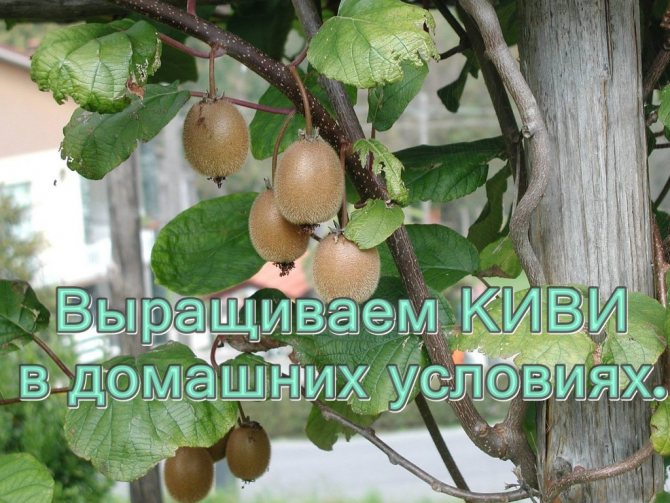

We grow kiwi at home
Contents of step-by-step instructions:
Dioecious plants contain in pairs
Special attention should be paid to the selection of the fetus. The fruit should be ripe and free from any flaws. The best time for planting planting material in the form of seeds is in the spring.
A well-washed fruit should be cut into several slices and with great care, knead the pulp, which contains the seeds. Then put all the pulp into a cup and pour some water over it. Further, the existing consistency must be stirred and do not forget to change the water, constantly adding fresh liquid.
During the washing process, use your fingers to carefully separate the pulp from the seeds. As a result, only kiwi seeds should float on the surface of the water.
Next, put the seeds to dry on a dry towel. Then, when the seeds reach a free-flowing state, they must be transferred to a rag in a saucer and covered with cloth on top. Further, on the matter under which the seeds are located, you need to pour water until it is completely wetted and close the saucer on top with a plastic wrap.
Kiwi seeds will germinate in 10-14 days. Now the seeds will only have to be planted in the ground, but before this process it is necessary to disinfect it by sterilization using the so-called water bath.
In order to properly plant seedlings, you need to use any shallow pot with a layer of drainage poured into it in advance, which may consist, for example, of expanded clay.
When the seeds germinate, they need to be planted in holes 5 mm deep no more. After sowing, the seeds must be spilled with water and covered with foil, setting the pot in a warm place. A few days after the first shoots appear, the soil must be shed again with water, while removing all weak borings.
When the sprouts reach 10 centimeters in height, they will need to be planted in individual pots.
The soil for a fruit called kiwi should consist of peat, black soil and sand. Moreover, peat should be present here in smaller quantities. The soil should be moist, drying out for kiwi is simply unacceptable and loose.
In addition, after disinfecting the soil with boiling water, and maybe bleach, as well as pouring the soil into the pot, it is recommended to add a spoonful of eggshell and tree resin to the soil.
Lighting
Kiwi is a southern and tropical plant, as a result of which this plant requires good and necessary lighting for it. It is recommended to install a pot of kiwi on the southern part of the balcony or window sill.
You can also use additional lighting with artificial light bulbs. You can arrange special vertical lighting for the vine.
For kiwi, it is important to avoid direct sunlight, as the plant can get burned. The light should fall on the plant from the side or from a window covered with gauze or some other material.
Conditions for flowering
Kiwi begins to bloom, and then bear fruit in the third or even fourth year of life. Vines begin to bloom at maturity. The flowers should be large with 5-6 petals starting from white and gradually turning yellow.
Male plants in a flower have many stamens, while female kiwi have both pistil and stamens. And due to the fact that the pistil in the flower of a female plant is located above the stamens, it can be cross-pollinated with pollen from another plant. Here insects come to the rescue, which transfer pollen from one flower to another.
In order to get fruits from this kiwi tree in the future, you need to learn how to pollinate yourself, since in natural conditions bees and bumblebees are engaged in this process.
If more male plants have grown, then buds from female species can be easily grafted onto them for normal flowering and fruiting.
Top dressing
In the spring, during the growing period of kiwi, you can start feeding. This process should be carried out as follows - dressing is applied twice a month from spring to autumn.
The feeding itself consists of alternating mineral fertilizers and organic fertilizers.
• During the growing season in March.
• After frost - in May.
• At the end of the formation of the fruit.
It is best to use a top dressing consisting of vermicompost or compost, but not more often than once a year. You can also make a small trench around the plant and put fertilizer there. When watering, gradually, the substances necessary for kiwi nutrition will reach the root system of the plant.
Water the kiwi plentifully. And in order for the root system not to rot, excess water from the pallet must be drained in time.
On very hot days in the summer, the liana, in addition to watering, must be regularly sprayed. In the summer, the temperature of the water should reach 25 degrees, and in winter, the temperature regime can be reduced to 10 degrees, and therefore watering at this time of the year must be reduced.


During the growing period, the plant needs to be watered more often at least 2-3 times a week.
The leaves on the plant should be inspected from time to time for the presence of a fungus or for the possible appearance of pests.
• If you do not find the fungus that has appeared in time and do not start cleaning the leaves.
• Kiwi can pick up pests from other plants. In this connection, it is considered more advisable to keep the vine away from other indoor flowers and plants.
• In the fall, it is necessary to remove old shoots from the plant - if the branches of the vines have already borne fruit, then it would be better to remove them. This method will enable the liana to grow overgrown with new branches and bear fruit abundantly for many years.
• If the kiwi is not provided with sufficient watering, necessary fertilizing, and poor lighting, it will die.
If kiwi grows on a balcony or veranda, it is better to wrap the plant, and thereby protect it from cold and frost.
Important! Pets, namely cats, according to many observations, love the leaves and twigs of this plant. Therefore, in order for the plant and kiwi fruits not to die all the time from broken twigs and eaten leaves, it must be fenced off, for example, with a net.
But by and large, kiwi rarely gets sick and becomes infected with pests, even at home. But regular inspections of the plant still need to be carried out. For loyal and good care, the plant will thank its household members and present them with delicious and juicy fruits grown independently.
a source
Kiwi - Chinese actinidia or delicacy, grows in the shape of a vine, comes from the mountain forests of China, is thermophilic and demanding of light. Plants are male and female, that is, kiwi is dioecious. This means that fruit can be expected if two vines of different sexes are kept at home. It is possible to understand whether our plant is male or female, only by the structure of the flower, and kiwi blooms at best at 2 years of age, sometimes at 6 years of age. Therefore, you need to sow and grow not one, but several plants.
Lighting
The first shoots will appear no later than a week later. From this point on, the kiwi plant needs good lighting, so you need to keep it on the windowsill or on the balcony.
Capacity
It is better to choose a container for kiwi with a wide bottom so that the roots can develop well and give an excellent harvest.
Transfer
After the appearance of the first pair of leaves, the first transplant (dive) and thinning are done. Weak, defective shoots are removed, strong ones are transplanted into separate containers. Subsequent cultivation will require more than one transplant; at the first stage, the vessel may be small, about 10 cm in diameter. If you start thinning with a delay, then it is better not to pull out the extra shoots, but to cut them off, because the shallow roots, even in kiwi seedlings, grow strongly and quickly in width. This feature should also be taken into account when loosening the soil, which must be done without fail, but carefully.
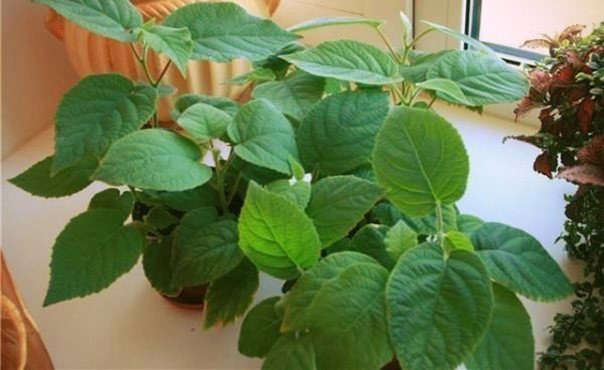

Practice shows that grown kiwi plants respond well to compost fertilization. At home, this has to be done differently than in the open field. A shallow groove is dug around the circumference of the pot, fertilizer is poured and carefully sprinkled with earth.
When watering, nutrients are successfully dispersed in the thickness of the substrate and reach the roots. Caring for this plant at home is not difficult. Moderate watering, loosening the soil, periodic application of mineral fertilizers and organic matter (you can rely on ready-made compositions from the store). As well as keeping on a light windowsill and lighting, so that the daylight hours are at least 10 hours. Drafts are undesirable.
The main reasons for the death of a plant include:
- insufficient moisture or over-watering;
- bad light;
- lack of useful elements in the soil;
- plant damage by fungal diseases and pests.
The most common diseases include:
- remove all affected foliage and stem sections;
- get the plant out of the container, flush the root system and remove its rotten parts;
- transplant kiwi into clean soil;
- spray the plant and water the soil with a fungicidal solution.
Did you know? Kiwi has the ability to ripen even after harvest.
When pests appear on kiwi:
- pruning of withered and dried leaves is carried out;
- all parts are washed with a solution of laundry soap;
- spraying with a special infusion, which contains garlic, onion, tobacco or wormwood;
- in the absence of effectiveness from spraying with infusion, they resort to the use of insecticides.
Growing kiwi at home is a very long process, and if you set yourself the goal of getting a harvest, you will have to spend a considerable amount of time on it. On the other hand, you can boast of a self-grown exotic fruit.
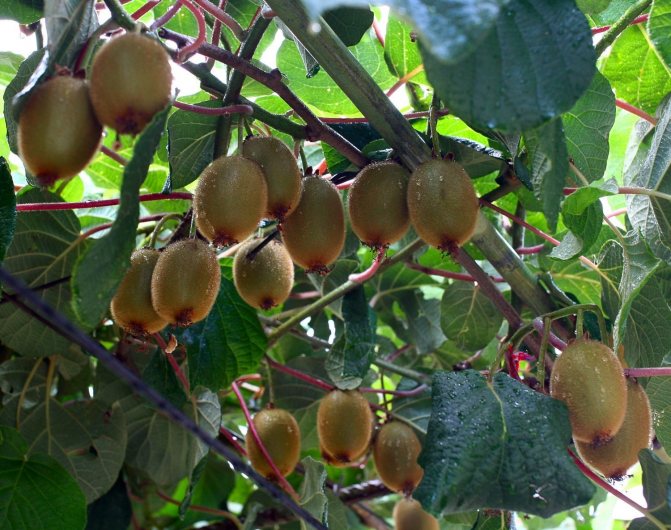

To take care of the fruit tree efficiently, bring the growing conditions as close as possible to their native, natural ones. Kiwi grows in a climate of long, warm and humid summers. In addition to low humidity or an excess of water, the plant does not like:
- cool climate, temperatures below 20 ° C;
- a sharp drop in temperature even in warm weather;
- wind;
- lack of sunlight.
Advice. If these features are taken into account, you can take the plant outside in summer, and at other times of the year - on a warmed loggia or balcony.
Basic requirements for growing
So, the growing process is not difficult, but you will have to show accuracy, care and patience.
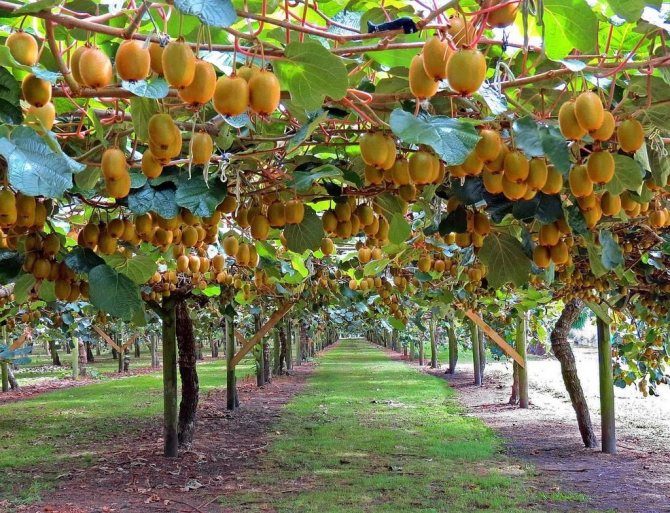

How kiwi is grown
You can grow kiwi:
- cuttings;
- seeds;
- accessory buds of the roots.
All methods have their own nuances, advantages and disadvantages, which we will get acquainted with a little later. However, there are a number of general rules that apply to kiwi breeding.
Kiwi is a distant relative of grapes, and therefore uses a similar cultivation technology here. The described culture is warm and light-requiring, therefore it must be located in a well-lit place (preferably without drafts). It should be remembered that the direct rays of the sun can lead to burns of foliage, therefore, the light should fall from the side. An even better option is vertically directed artificial lighting.
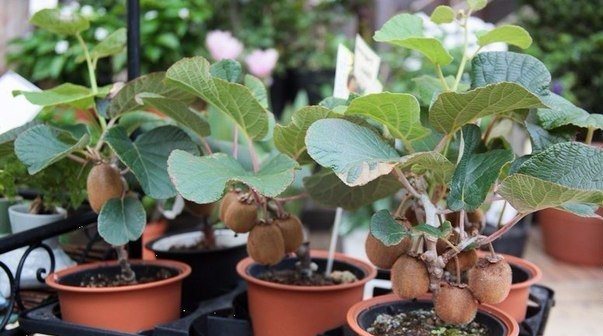

In the process of development, the pots should be periodically scrolled clockwise (every two weeks, 10-15 °). This will provide the plants with a straight silhouette, and the crown will turn out to be dense and uniform.
Note! There are many varieties of kiwi, but, characteristically, almost all of them are suitable for growing at home.
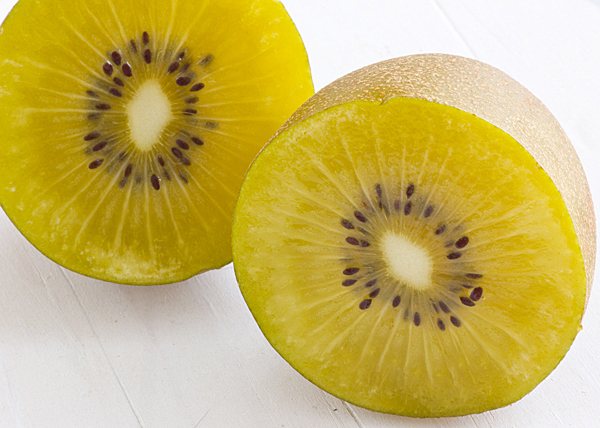

It should also be remembered that kiwi is a dioecious crop, and therefore one male and at least two or three female plants are required for normal fruiting. If kiwi is grown from seed, then about 80 percent of the seedlings are male, so there should be as many of them as possible.
Now let's look directly at the workflow.
Basic rules for growing
Growing kiwi at home is not difficult at all. But this task will require your attention, accuracy and the ability to wait.
Kiwi can be grown in several ways:
- from seeds;
- cuttings;
- root suckers.
Each of these methods has its own characteristics, which we will describe in detail. But there are some general rules for growing kiwi.
Kiwi is a vine, akin to grapes, which means that it has the same requirement. This plant loves a lot of warmth and sunshine. Therefore, he will need a place where there is a lot of sun and no drafts at all. However, do not forget that direct sunlight can burn the leaves of the plant. It is better if it receives light from the side. It's great if you can provide artificial vertical lighting for the kiwi. While growing, rotate the plant pot clockwise 10-15 degrees every two weeks. In this way, the vine will maintain a straight silhouette and develop an evenly dense crown.
There are many varieties of kiwi, and almost all of them are suitable for self-cultivation at home. For the kiwi to start bearing fruit, you need to plant a male and female plant - this is necessary for pollination. If you breed kiwi from seeds, you will have to wait for flowering to determine the gender of the vine. Usually kiwi begins to bloom at 6 years of age, sometimes earlier.
Please note: Kiwi is a dioecious plant. This means that for fruiting, you need at least 2-3 female plants per male. When grown from seed, 80% of the plants are male, so it is best to grow more seedlings.
Growing kiwi from seeds is a rather painstaking task, it will require special attention from you. We will tell you about it in detail.
Kiwi - growing at home
It is better to start growing kiwi in early spring, because then the highest germination of seeds is observed. This is a very important point, so do not delay sowing.Also consider the fact that kiwi naturally grows in regions with long and warm summers, so the conditions for the plant should be as comfortable as possible.
Traditionally, the process begins with the preparation of everything needed.
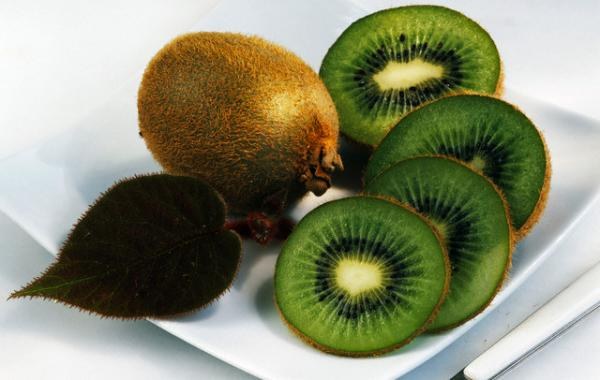

If you really want to grow kiwi at home, make sure you have enough free space.
Stage one. We prepare everything you need
To grow vines, you must prepare:
- one ripe kiwi fruit;
- neutral or slightly acidic soil intended for citrus crops (you can purchase it at any specialized store);
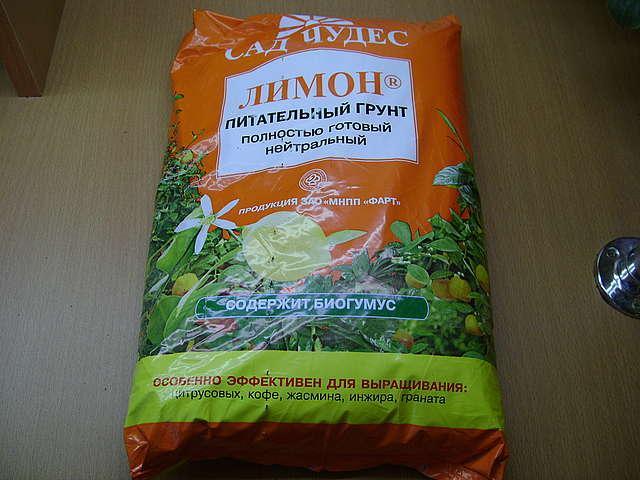

Citrus primer
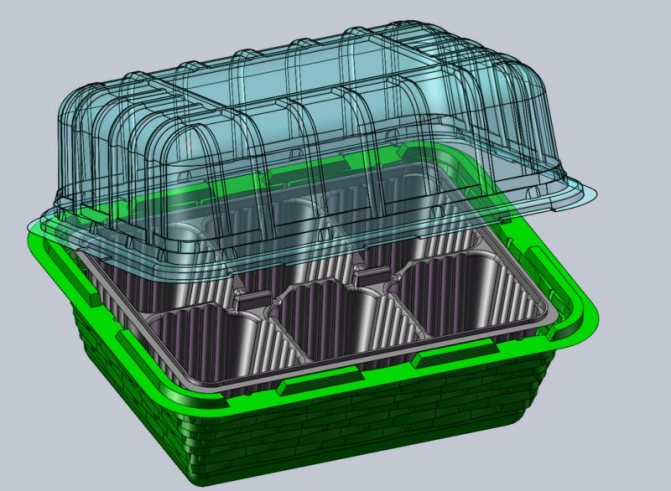

"Shop" soil can be replaced with a self-prepared soil mixture consisting of peat, sand and black soil (in equal proportions). By the way, when you dive seedlings into pots, this soil mixture will also work well, only there should be less peat in it.
Stage two. Preparing the seeds
Cut the fruit in half
Take a ripe fruit and cut it in half. You can eat one part, and extract about 20 grains from the other. Peel the pulp from the grains (otherwise they will rot in the ground), but do it carefully, do not damage the shell. To simplify the procedure, you can throw the seeds into water, mix them well and leave to settle for a while. Repeat the process two to three times to minimize the risk of seeds rotting.
Growing kiwi from seeds
To grow a vine from seeds, you will need:
- ripe fruit;
- river sand, well washed;
- fine expanded clay, which will provide drainage;
- mini greenhouse (can be replaced with plastic wrap;
- prepared soil of a slightly acidic or neutral type for citrus fruits or roses (available in specialized stores).
A mixture of black soil, peat and sand can be used as soil for germinating seeds. When replanting seedlings into pots, this mixture will also work great, but you need to use less peat.
Follow the step by step instructions to get a quality result.
- Mash the kiwi fruit until puree and remove the seeds. Rinse them thoroughly, mix with moistened river sand.
- In order for the seeds to germinate well, they need to be stratified. Keep the dishes with the mixture of sand and seeds for 2 weeks at a temperature of 10 to 20 degrees, then place in the refrigerator for 2-3 weeks.
- Lay small expanded clay at the bottom of the growing pots, pour soil on top. Mix the top layer of soil with a mixture of sand and seeds. Moisten with room temperature water.
- Place the seed pots in a mini-greenhouse (you can cover with foil or glass). Install them in a well-lit, warm place. Remember to spray and ventilate daily.
- As soon as the first shoots appear, start accustoming them to fresh air. Remove the lid from the greenhouse every day for a few minutes, gradually increasing the time.
- When the second pair of true leaves appears, make a dive and plant the plants in separate pots. At the same time, be careful: the root system of the kiwi is very delicate, located on the surface, it is easy to damage it.
Features of vegetative reproduction of kiwi
Seedlings of this culture are grown using the same technology as described above. The only difference is that the seed must be sown in January. Two years later, a kiwi of one or another variety is grafted onto a seedling, which by that time will grow up and get stronger.
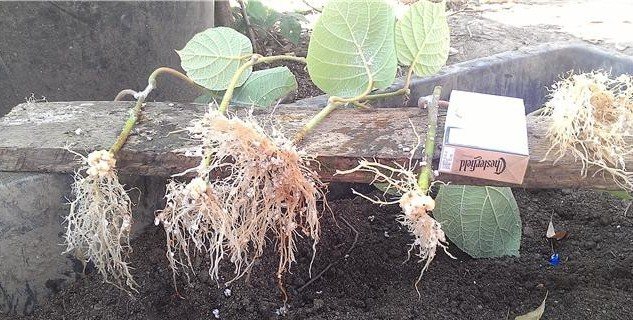

Seedlings before planting in soil
Grafting can be done in the same ways that are used for other plants; in particular, these are:
- budding;
- cleavage with a green handle;
- a similar process, but with a lignified cuttings.
The vine can then be planted in open soil.If the kiwi will be grown indoors, as in our case, then you should take care of a container of sufficient depth (the roots should have a lot of room for further growth).
You can also grow seedlings from rooted cuttings. The disadvantage of this method is the low germination rate in indoor cultivation - there are either few or no plants at all. As for further care, it is the same as when growing by seeds. When the cutting / seedling enters a period of active growth, it will no longer be afraid of low temperatures and can easily adapt to any conditions.
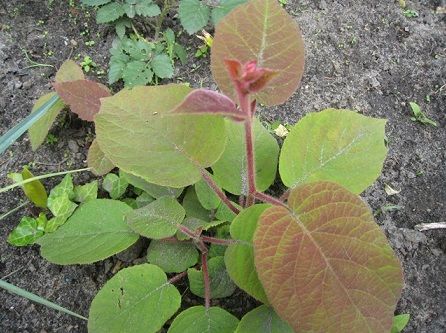

Planted kiwi seedling
Propagation by seedlings and cuttings
Kiwi seedlings are grown from seed in the same way as described above. The only difference is that the seeds need to be sown in January. After two years, the kiwi variety you want can be grafted onto the hardened and grown seedling.
The grafting methods are the same as for other horticultural crops:
- into the cleft with a lignified cuttings;
- in the cleft with a green handle;
- budding.
You can even plant your kiwi outdoors afterwards. If you plan to keep the plant indoors, provide a large, deep container so that the root system has enough room to grow and develop.
You can grow seedlings from rooted cuttings. This method of vegetative propagation is excellent for green and lignified kiwi cuttings. The disadvantages include a low percentage of the output of rooted cuttings: at home, very few of them are obtained or not at all.
Growing kiwi in this way does not require much hassle and is no different from caring for a plant grown from seed. A seedling or stalk that has entered a period of active growth is not afraid of snow and frost, it is easily adaptable, so it can be planted in open ground. In the first years, it is enough to cover the liana for the winter, for example, with coniferous branches, if there are often severe frosts in your region.
Please note: For some reason, cats love kiwi leaves and twigs. If you have a pet at home, try to protect the plant from it, for example, by enclosing it with a net. Otherwise, the kiwi may die due to constantly broken off branches and eaten leaves. Other pests to this plant are practically not dangerous.
How to get a big harvest?
Liana needs to be placed correctly. It needs a lot of space, so it is better to grow it on an insulated balcony. Also organize a support along which the plant will climb, or make a beautiful and original balcony frame out of it. The length of one liana, by the way, can reach seven meters.
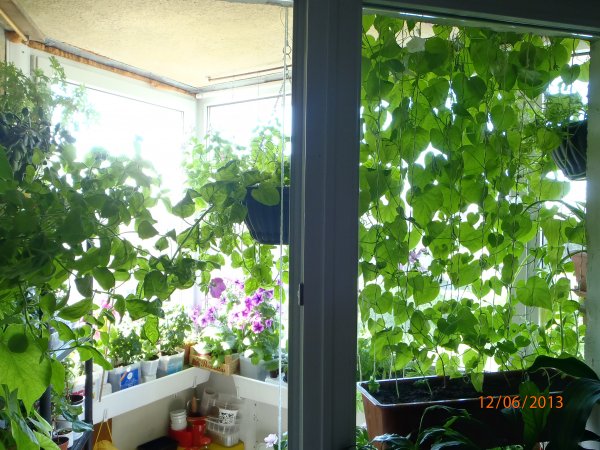

Note! Pollination should be taken care of to obtain fruit. In natural conditions, insects are engaged in this, in our case, you must do everything with your own hands.
If there are too many male vines, you can plant "eyes" on them from female vines, which will allow you to get fruit. Ideally, five or six females should fall on a male plant, and if the proportions are not correct, then it is better to vaccinate. The "eyes" take root well, thanks to which the yield will increase significantly.
Video - Kiwi inoculation
Also, periodically inspect the kiwi leaves, and for two reasons at once.
- This will allow you to detect the fungus in time and clean the leaves.
- Liana can "become infected" with various pests from neighboring plants, so in addition to inspection, try to place kiwi as far away from them as possible.
With the onset of autumn, cut off old shoots: those branches that have already borne fruit are recommended to be removed. This will free up space for new shoots, and the vine itself will not age and will bear fruit for many years.
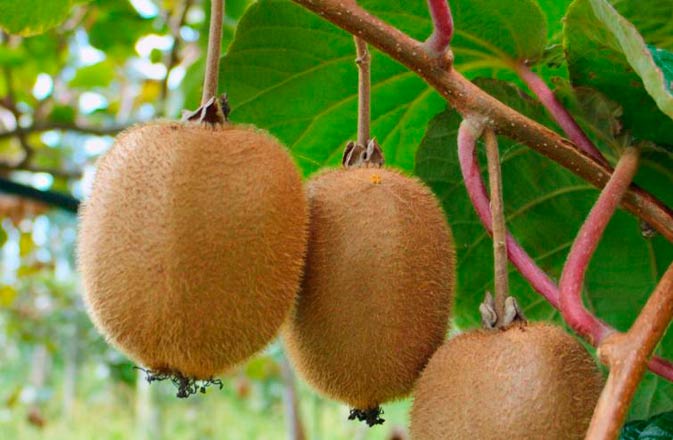

If the vine grows on the balcony, then in winter you will have to additionally protect it from frost. To do this, remove the shoots after scrapping and wrap them up. When spring comes, they will sprout more young shoots.
And in conclusion - one more useful advice.For some reason, cats love the branches and foliage of kiwi, so if you have such a pet, then take care of protecting the plant - you can, for example, enclose it with a net. Otherwise, the kiwi may die.
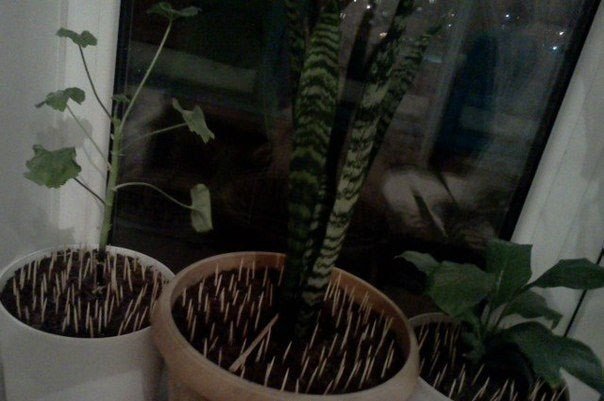

How to wean a cat from walking according to flowers? Ordinary toothpicks will help you.
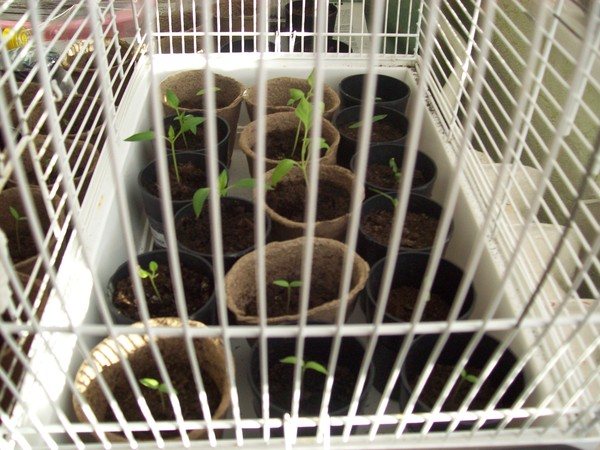

Seedlings in a cage
Sex determination of culture
Flower growers love kiwi not only for high fruiting rates, but also for long flowering. Large flowers, consisting of five to six petals, over time begin to change their color from snow-white to lemon, lime and yellow.
Kiwi yields when grown at home are often slightly less.than the manufacturer of a certain variety promises. But in terms of the number of useful components and trace elements, they are not inferior to those crops that are grown in natural conditions. The ripe crop is simply separated from the vine. You need to store it in the refrigerator, the storage time reaches 10-14 days.
The gardener has no difficulty in obtaining seeds from kiwi at home. They are allowed to be taken from any berry purchased in the store. But seedlings grown in this way very rarely inherit varietal characteristics from the parent, and the taste of their fruits is not so rich and pleasant. In most cases, they are used as a rootstock, and any seedling of the selected kiwi variety, which can be bought in a special nursery, becomes a scion.
Fruits from seed-grown crops take a long time to grow. Most often, flowering in such plants begins no earlier than six weeks after planting in the ground.
For proper formation and growth of culture, it is important to provide good lighting and warmth. The pot with the plant is placed on the lightest windowsill in the house, for example, on the southwest or south. It is also very important to carry out regular feeding (it is best to use organic fertilizers) and develop the correct watering regime.
For some reason, kiwi juice affects cats (and to a lesser extent cats) in much the same way as valerian tincture. It is important to remove the pot in a place where the animal will definitely not be able to get to it, or to surround the culture with a special protective net.
How did we hear about kiwi?
It is believed that people owe their origin to New Zealand. This is completely wrong, although the tree got its catchy and short name thanks to enterprising New Zealand traders. The plant was named after a small bird that resembles its fruit in appearance.


The real homeland of the "shaggy" berry is China. Until XX in New Zealand, they did not even know what a kiwi tree looks like. It grew wild in Eastern and Northern China for three hundred years, until a friend of Alexander Ellison brought him a few seeds of an unknown fruit as a gift.
Allison began cultivating the kiwi tree, calling it "Chinese gooseberries." The wild fruit was much smaller and harder than modern fruit. To make it tasty and attractive, Alexander Ellison spent a lot of energy and more than 30 years of his life, however, only the gardener's relatives knew about it.
The kiwi world was discovered by Ellison's neighbor James McLocklin, turning the cultivation of vines into a gold mine. In the 1960s, he acquired a whole plantation of wonder berries, selling them abroad. New Zealand is now one of the largest suppliers of kiwi. It is grown in Japan, Greece, Chile, Iran, Italy and other countries, but mainly for the domestic market.
Important conditions for a good harvest
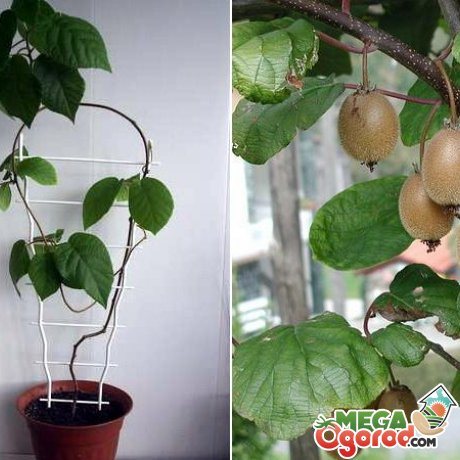

Liana needs proper placement. It takes up quite a lot of space, so an insulated balcony will be the best place to grow it. It is necessary to organize a support for it, along which the vine can rise up, it can be made with a frame of a balcony window so that it looks beautiful. The total length of each vine can be up to 7 meters.
To obtain fruits, flowers must be pollinated: in nature, this work is done by bees and bumblebees, in greenhouse and indoor conditions, the owner must take care of pollination.
If it turns out that there are too many male plants, buds from female plants can be grafted onto them to get fruits. To get a good harvest, you need 1 male plant for 5-6 female plants, so if the ratio is wrong, it is better to transplant the "eyes". They take root quite well, so the method will increase yields.
It is necessary to constantly inspect the leaves to:
- In time to identify the appearance of the fungus and take measures to clean the leaf blades.
- Kiwi can become infected with pests from other indoor plants, so inspections should be carried out as often as possible, and if possible, keep the plants away from other indoor crops.
- In autumn, it is advisable to remove old shoots: if the branches of the creeper have already borne fruit, it is better to remove them. This will make room for new shoots, and the vine will not grow old: this will allow it to bear fruit for many years.
If kiwi is grown on a veranda or on an uninsulated balcony, in winter you need to take care of protecting the vines from the cold. After pruning, the shoots are removed from the trellises, they need to be wrapped so that they can calmly survive the cold period. In the spring, after waking up, they will actively give young shoots.
Growing kiwi on your own is not as difficult as it might seem. Chinese gooseberry is not a very whimsical culture, and it is quite possible to create suitable conditions for it at home. This will surprise guests with delicious fruits, which for many are still exotic overseas.
More information about planting kiwi seedlings can be found in the video.
An exotic kiwi plant can be grown in a city apartment on a windowsill or in a country house on your own. Cultivating actinidia is a very exciting process. If you follow the simple rules of farming, you can get kiwi from the tiny seeds that are inside the fruit. If you fulfill certain requirements and create the necessary conditions, then a strong, fruiting vine will grow from a small bone, even on the windowsill.
To grow kiwi at home, you must first choose the right planting material. A well-ripened fruit without any flaws is selected for planting. The best time to cultivate this crop at home is spring. You can plant and grow kiwi in an apartment from a stone.
The fruit is washed well with warm water and cut into slices. The pulp is gently kneaded, and then put in a plate of water. Mix the consistency thoroughly by adding fresh water. Rinse the pulp until the seeds separate. As a result, only seeds should float on the surface of the water.
After that, they are laid out on dry gauze to dry. When the planting material becomes free-flowing, it is transferred to a damp cloth in a plate and covered over with a cloth. Kiwi seeds need to be constantly moisturized. To make them hatch faster, you can cover the plate with a transparent film on top.
After about two weeks, the seeds will sprout. Now all that remains is to plant them in the ground. But before that, it is necessary to steam the soil in order to disinfect it. Growing kiwi fruit in an apartment from seeds is a rather laborious process, but very exciting.
Seeds sprouted on a damp cloth are planted in pots, embedded to a depth of about 5 mm. After sowing, the ground is watered, and the pot is tightened with a transparent film. The pots should be in a warm and bright room. You cannot put flowerpots in the sun. The first shoots will appear in a few days. At this point, the kiwi is again watered with water at room temperature and all weak shoots are removed, leaving only strong plants.
When the kiwi sprouts reach a height of 10 cm, they are planted in larger separate pots.In a few years, it will be possible to vaccinate any kind of kiwi on young seedlings.
Almost all growers seeking to improve their own skills at one point decide to grow fruit-bearing crops, such as citrus fruits, coffee or vines. And many are wondering if it is possible to start growing kiwi at home. In reality, this is quite possible, however, certain requirements must be observed in the process.
How kiwi appeared: an interesting fact
Kiwi is also known as Chinese gooseberry. And in order for this culture to begin to bear fruit, you need to simultaneously grow two varieties of plants - male (required for pollination) and female. If you plan to grow with seeds, then be prepared to wait for the flowering period, because that's when you can determine the gender of the vine. In most cases, kiwi blooms in the sixth year of life.
Origin story
It is believed that the first varieties of kiwi were bred and cultivated in China, where this plant was called yang tao (translated from Chinese - strawberry peach). Later, Europeans began to call kiwi "Chinese gooseberry", and this berry began to be in demand all over the world.
In order for the fruit to become more in demand on the market, New Zealand producers in 1962 came up with a more attractive name for it, which has been assigned to it to this day - kiwi. The producers borrowed the new name from the flightless kiwi bird, which has a distant similarity in shape and color to this fruit.
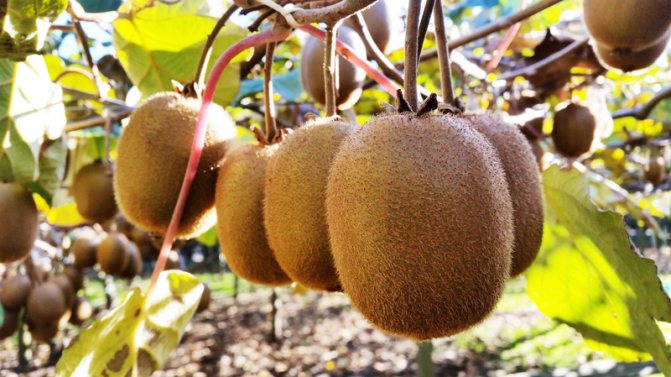

In scientific circles, kiwi is called actinidia. It is quite sensitive to temperature and climatic conditions. Even the smallest deviations from the temperature norm required by the plant are enough to reduce the level of its flowering, and this entails the destruction of fruits and the death of the entire plant.
Since the kiwi is a rather picky plant, the branches of which react very sharply to the surrounding conditions, many attempts to grow the crop of this fruit in different regions and climatic conditions did not bring positive results. On the contrary, growers willing to grow kiwi suffered significant losses.
Despite the fact that actinidia is native to North China and the coast of East China, where it was cultivated for three centuries, this fruit did not receive much popularity and demand there. This is due to the limited amount of land that is suitable for large-scale plant cultivation and the density of the population on suitable land. Not so long ago, the Actinidia vine was quite common in the natural wild environment, it curled freely through the wild trees.
Main varieties
There are a large number of varieties of kiwi varieties.... However, there are several species that are massively grown for export and are popular around the world:
- Hayward is the most common cultivar in the world. This is due to the large fruits and excellent presentation. The weight of the fruit is on average 120 grams, the fruit itself has an oval shape, flattened on the sides. The pile is thin, soft, the peel has a marshy, brown color with a green tint; in a ripe fruit, it is easily removed without damaging the pulp.
- Bruno is the leading commercial dessert variety grown by almost all kiwi growers. The fruits of this variety are characterized by a dark brown color and thick pile on the skin. It has a juicy green pulp with a yellow tinge and a persistent aroma, the average weight of one ripe fruit is 90 grams.
- Monty is a technical variety as the commercial quality of this fruit is rather low. It is small, and its shape is very uneven, the average weight is about 30 grams, the skin color is dark brown. The fruit has a very thick and soft bristle, juicy and bright green pulp, which distantly smells like pineapple.
- The Abbott variety is distinguished by high yields. This plant is quite demanding in terms of soil and air moisture. The size of the fruit is medium, has a shape that vaguely resembles a pear and weighs an average of 45-50 grams. There is a long soft bristle on the brown skin.
- The Allison and Abbott varieties are quite similar to each other, however, the Allison fruit is somewhat expanded at the bottom and looks like a bell. The skin of the fruit has a brown color and is covered with a thin nap. The average weight of one Allison kiwi is 40 grams.
Preparing seeds for planting
The best time for planting kiwi is spring: from March to May, during the summer months the seedling will grow, get stronger, and there will be enough light for it to grow. It is better to take the soil loose, moisture-absorbing and breathable.
Do not use soil from front gardens or vegetable gardens.
For kiwi, you can use a special citrus soil, in extreme cases - a universal one.
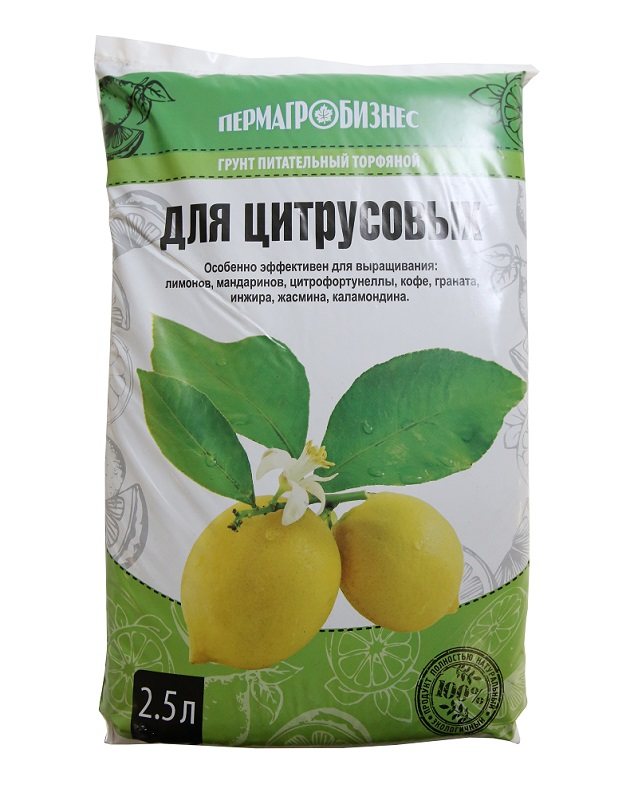

For planting kiwi, you can use citrus soil
If possible, it is better to make the soil by yourself from universal soil, coconut fiber, vermiculite and vermicompost.
For a 10-liter pack of universal soil add 2 liters of soaked coconut fiber from a briquette, 1 liter of vermiculite, 1-2 liters of vermicompost. Mix everything well so that the components are evenly distributed over the soil mixture.
Kiwi crown formation:
Kiwi has a very fast growth, at home it is very important to control the growth of the vines, give it a more aesthetic and compact look, without which it can easily reach a length of more than 7 meters.
The formation of the plant begins when it reaches a height of 30 cm, the top is pinched to it, removing 2-3 upper buds, which stimulates branching. Branching must be controlled, since an overabundance of greenery is harmful to the plant, all nutrients go to its maintenance, so often the fruits fall off even before ripening, or are not tied at all.
Pruning of plants is carried out only in spring, so that new shoots have time to lignify over the summer and they cannot be damaged by autumn temperature drops.
An adult plant in indoor conditions should have from 5 to 7 shoots, which should start at a height of 45-50 cm from the ground. Kiwi on the shoots will constantly grow growth, which must be shortened throughout the spring-summer period, since fruits are formed only on the lower 5-6 buds of each annual shoot, and excess greenery only takes away nutrients from the plant. That is why very long shoots are not formed on kiwi, this is impractical, the shoots are constantly pinched after 6-7 buds.
Once every 3-4 years, kiwi are rejuvenated, branches are removed on the lateral shoots, shortening them by 1-2 buds. Such rejuvenation is carried out in late autumn or no later than July. Female and male plants rejuvenate in the same way.
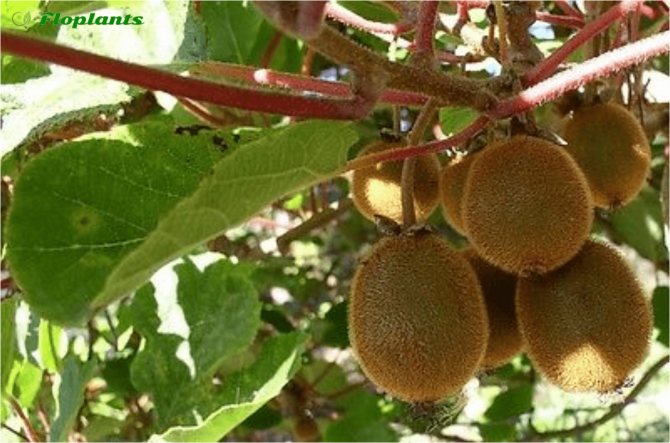

Actinidia Abbott.
Benefit
Due to its high content of vitamin C, kiwi is used in the treatment and prevention of many diseases. The benefits of one berry are comparable to a bucket of apples in terms of the content of vitamins and useful microelements: vitamins A and B, actinide enzyme, quinic acid, magnesium, calcium, potassium and phosphorus.
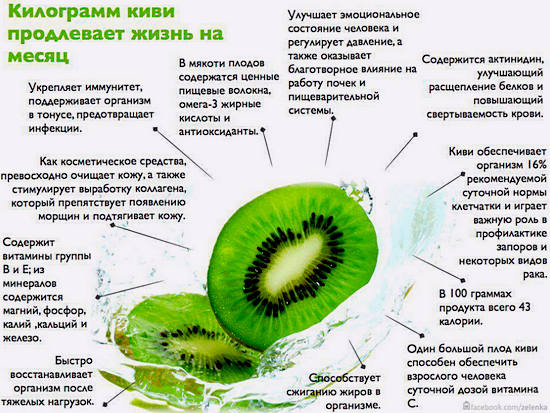

During pregnancy, the use of the fetus for food saturates the body with calcium and magnesium, which are necessary for the proper development of the baby. In China, the berry has established itself as a preventive measure against cancer. This is due to the content of ascorbic acid, which inhibits the development of cancer cells.
Diseases and pests threatening kiwi
Like any actinidia, kiwi rarely suffers from diseases and pests. This also applies to home grown specimens. But at the same time, you should not neglect the regular inspection of the vine. The earlier the problem is noticed, the easier it is to deal with it.
Often, the florist himself is to blame for the deterioration of the appearance and condition of the kiwi.The mistakes made by him in the care provoke problems with the plant.
Table: how kiwi reacts to improper care
| What does a plant look like | What is the reason |
| Leaves droop, lose their tone, partially or completely fall off. | Moisture deficiency. Typically, the plant recovers after watering. |
| Brownish-beige spots on leaves and stems. | Burn. The plant has suffered from direct sunlight. Stains are nothing more than dead tissue. |
| "Wet" black-brown spots at the base of the shoots. | Rot fungus. Its development is facilitated by a cool room temperature, especially in combination with excessively abundant and / or frequent watering. |
| Shrinking and yellowing leaves, reddening petioles, a general deterioration in the tone of the plant. | Nitrogen deficiency. Caused by the use of "poor" soil unsuitable for kiwi. Root and foliar top dressing is recommended with urea solution (1.5–2 g / l). |
| Shrinking leaves of an unnatural dark green color that have lost their luster, a sharp decline or lack of yield. | Phosphorus deficiency. The plant is fed with superphosphate. |
| The leaves take on a brick shade, dry quickly and fall off. | Potassium deficiency. Potassium sulfate can be used for feeding. Potassium chloride is not recommended - Kiwi chlorine, like all actinidia, does not like it. |
| The leaves change their shade to lime, blurry brownish spots appear between the veins. | Magnesium deficiency. Liana is fed with magnesium sulfate, potassium magnesium. |
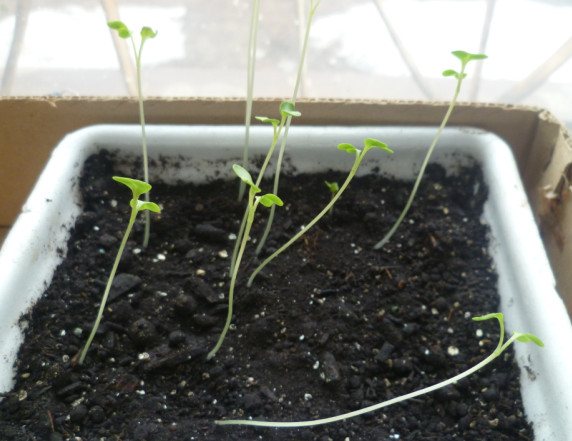

Due to the lack of light, the kiwi vine is ugly stretched out - this applies to both adult plants and very young seedlings
In addition to the so-called non-infectious diseases, the symptoms of which most often disappear when the microclimate is normalized and the correct feeding is carried out, kiwi can also suffer from fungal diseases. Most often, with waterlogging, various types of rot develop. Also, the plant is not ignored by such "universal" pests of indoor plants as aphids and scale insects. They are distinguished by their rare "omnivorousness".
Table: diseases and pests that can threaten kiwi when grown at home
| Disease or pest | Symptoms | Control and prevention measures |
| Phylostictosis | Large brown spots on the leaves with a darker edging. Sometimes the border may have a greenish or purple tint. In severe cases, gray-brown concentric rings around them. | The disease most often develops with a deficiency of potassium and phosphorus in the soil and an excess of nitrogen. At the first signs, the affected parts of the leaves are cut off, two treatments are carried out with Bordeaux liquid (10 ml / l) with an interval of 12-15 days. In severe cases, fungicides Strobi, Horus, Topsin-M, Delan are used. |
| Late blight | Dark brown vague spots on the leaves, longitudinal stripes of the same shade on the stems. Gradually, they are tightened with a grayish-white "down" with small black dots. Leaves dry, fall off. | At an early stage of the disease, the soil is spilled with a solution of Alirin-B or Ordan, the liana itself is sprayed with Fitosporin, Trichodermin, Quadris, Ridomil-Gold. Folk remedy - infusion of garlic. Carry out 4-5 treatments with an interval of 7-10 days, it is desirable to change the preparations. For prevention, you can tie the base of the shoot with copper wire or spray the plant with iodine solution every month (20 drops per liter of milk and liter of water). |
| Root rot | "Wet" black-brown spots at the base of the shoots, mold on the soil surface, an unpleasant putrid odor. The stems are easily pulled out of the ground. | If the disease has gone too far, it will no longer be possible to save the plant. In the early stages of rot development, you can try replanting kiwi, getting rid of all the stems and leaves on which the slightest damage is noticeable. The substrate is completely changed, the pot is sterilized. Sifted wood ash or Trichodermin is added to the soil.During a month, when watering, ordinary water and a pale pink solution of potassium permanganate or Fitosporin, Gamair, Baktofit alternate. |
| Gray rot | Rapidly growing grayish spots (like dust) on fruits, leaves and shoots, covered with a fluffy bloom of the same color. It is not recommended to eat infected kiwi. | If the disease is noticed on time, kiwi is sprayed daily with infusions of garlic, mustard powder until the symptoms disappear completely. Sprinkle the soil with wood ash, crushed chalk. In severe cases, fungicides are used - Teldor, Vectra, Skor, Tsineb (according to the instructions). |
| White rot | "Watery" spots on the leaves and fruits, dragging on with a thick whitish bloom, like cotton wool, rotting stems. The disease spreads from the bottom up. | Affected stems and leaves are cut off, the "wounds" are covered with a paste of water, crushed chalk and potassium permanganate, sprinkled with ash. If this does not help, plants and soil are treated with Topaz, Maxim, HOM. |
| Shield | Brown-gray, rounded "plaques" on leaves and shoots, rapidly increasing in volume. The tissues around them acquire a reddish-yellow hue, the soil in the pot turns black. | Visible scale insects are removed from the plant, lubricating their shells with kerosene, alcohol, vinegar, machine oil. The leaves are wiped with a foam of green potash or laundry soap. The plant is treated three times with an interval of 7-12 days with Aktara, Fufanon, Fosbecid. For prophylaxis, the vine is sprayed with hot pepper or onion infusion once a week. |
| Aphid | Colonies of small insects of yellow-green or black-brown color, clinging to the underside of leaves, tops of shoots, fruit ovaries. At the same time, they become covered with a transparent sticky coating. The affected parts of the plant are deformed, dry, fall off. | If there are few aphids, the plants are washed under the shower, 3-4 times a day they are sprayed with infusions of any herbs with a pungent aroma, garlic, onions, citrus peel, mustard powder, tobacco chips. In severe cases, general-purpose insecticides are used - Inta-Vir, Fury, Mospilan, Iskra-Bio. Usually 2-3 treatments are sufficient with an interval of 5-7 days. |
Photo gallery: diseases and pests dangerous for kiwi
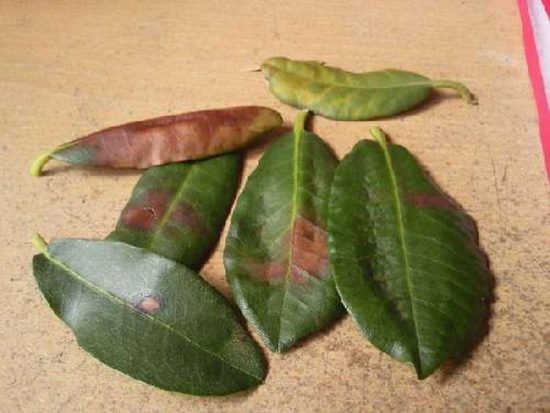

The development of phyllostictosis is most often provoked by improper feeding or their absence.
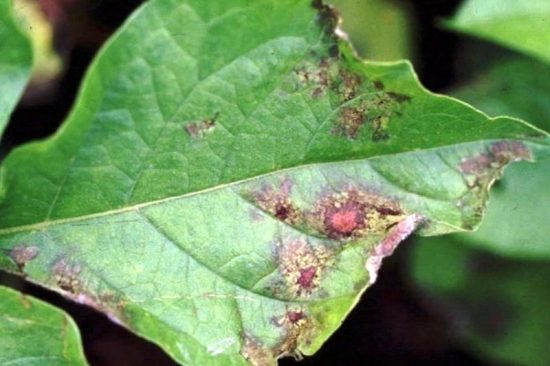

Late blight is also known as "brown rot" If the development of root rot has gone too far, the plant can only be discarded
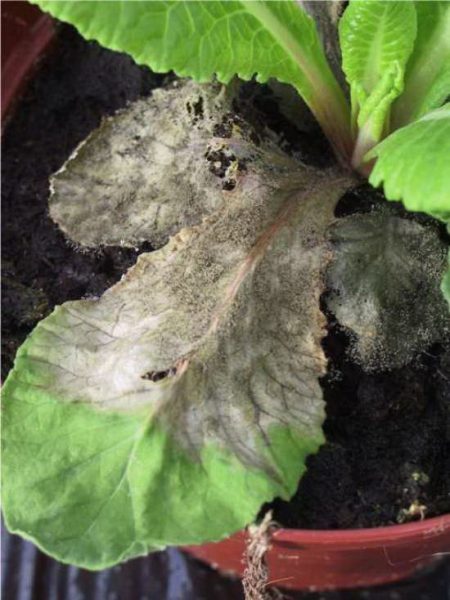

Gray rot affects not only leaves and stems, but also kiwi fruits
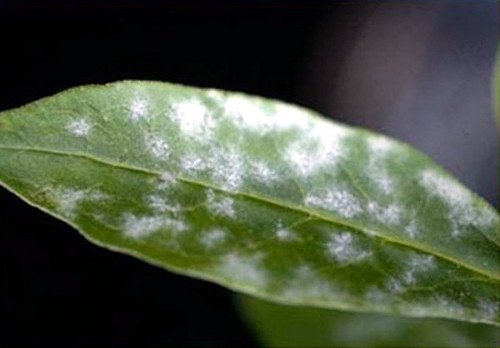

White rot is very easy to identify, but getting rid of this disease is quite difficult.
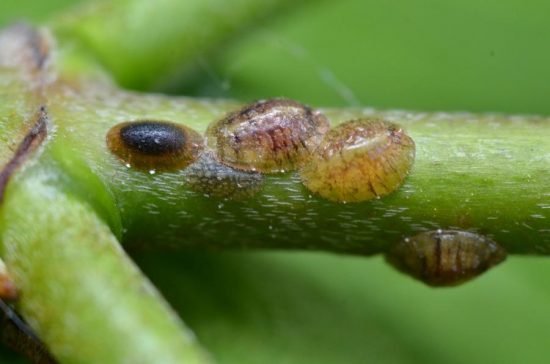

A durable shell reliably protects the scabbard, so most folk remedies are not dangerous for it
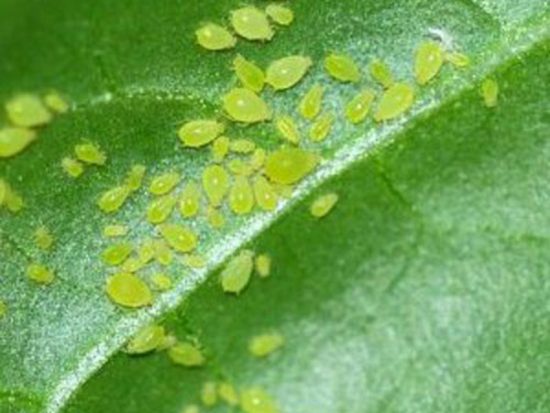

Aphids are one of the most "universal" pests; both indoor and garden plants are attacked.
What tree does kiwi grow on?
The exotic fruit comes from the genus Actinidia, which translates as "ray". All representatives of the genus have a characteristic radiant arrangement of the ovary columns (this is clearly visible if the kiwi is cut across). There are approximately 75 species. They are mainly distributed in Southeast Asia, 4 species can be found in the Far East of Russia.
Where kiwi grows - on a tree or a bush, is sometimes difficult to answer. Actinidia are considered woody lianas, but sometimes they are also called shrubs. However, regardless of whether a kiwi is a tree or a shrub, its fruit is a berry. It combines several flavors, sweet and sour at the same time.
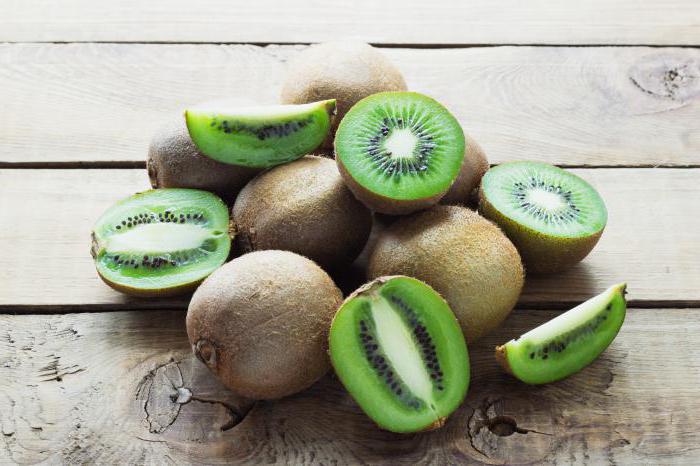

Outside, the berries are unsightly, resembling a potato covered with villi. The average size of a ripe kiwi is 100 grams. Inside, it usually has a rich green color. There is a "gold" variety of this plant (Gold kiwi), the fruits of which are yellow.
Growing conditions
In its natural habitat, actinidia prefers shade, but also likes to be in sunlight.The kiwi vine must be protected from the wind, because in the spring, when its gusts may be too strong, damage to young shoots is possible.
When kiwi is grown on an industrial scale, the vines of this plant need a serious suspension system, it will replace them with the usual natural conditions to which the plant is adapted. The standard version of the device of such a suspension system is a mesh that is attached to supports made of pillars.... The main features to consider when growing kiwi:
- The most favorable for growing kiwi is moderately acidic soil, which is rich in organic matter and has a good drainage system.
- Kiwi categorically does not perceive saline soil and will not grow there even with good fertilization.
- Throughout the growing season, the plant needs a large amount of moisture, but the water in no case should stagnate, this will lead to rotting of the vine and roots.
- In the hot summer period, you need to regularly water the plant, since it does not tolerate dry soil and will quickly die.
The main symptoms of moisture deficiency in kiwi appear instantly in the form of sagging foliage, which begins to dry out along the edge, in addition, the bush can completely throw off the foliage from young shoots. The most common cause of death of actinidia is a lack of moisture.
Since this plant is a powerful consumer of nitrogen, during the first half of the growing season it is necessary to fertilize it with nitrogen fertilizers as often as possible. If you use them when the fertile season comes to an end, you can increase the size of the fruit itself, but this will directly affect the transportation of products in the future, since it will lead to a deterioration in the preservation of the fruit. Mulching using manure or straw will be of great benefit to the plant. It is impossible for the mulch to come into contact with the vine, since this can cause the shoots to rot.
In order for the plant to bear fruit well, it must be cut off for the winter. Despite the fact that actinidia bushes are practically not exposed to diseases and insect attacks, there is still some threat to them. An unconventional problem is that the kiwi vine has the same scent as catnip, so it attracts these animals to the plant. This is a threat as cats can damage the trunks of young plants and thus kill the kiwi. In addition to the cat, garden snails, which absorb the moisture necessary for the vine, are often problematic for young bushes.
For the possibility of comfortable transportation, storage and direct marketing of kiwi fruits, they are sampled when the fruit is still firm and not fully ripe. As a result, he does not pick up a sufficient amount of sugar, which accordingly affects the taste of the product. When kiwi fruits are grown on plantations for their own consumption, they undergo a full ripening process and only then are they harvested.
What top dressing can be used for kiwi
Most of all, kiwi loves organic feeding, both at an early age and when the plant is already an adult. The best feeding is considered to be vermicompost, dry, in bags, or liquid in bottles.
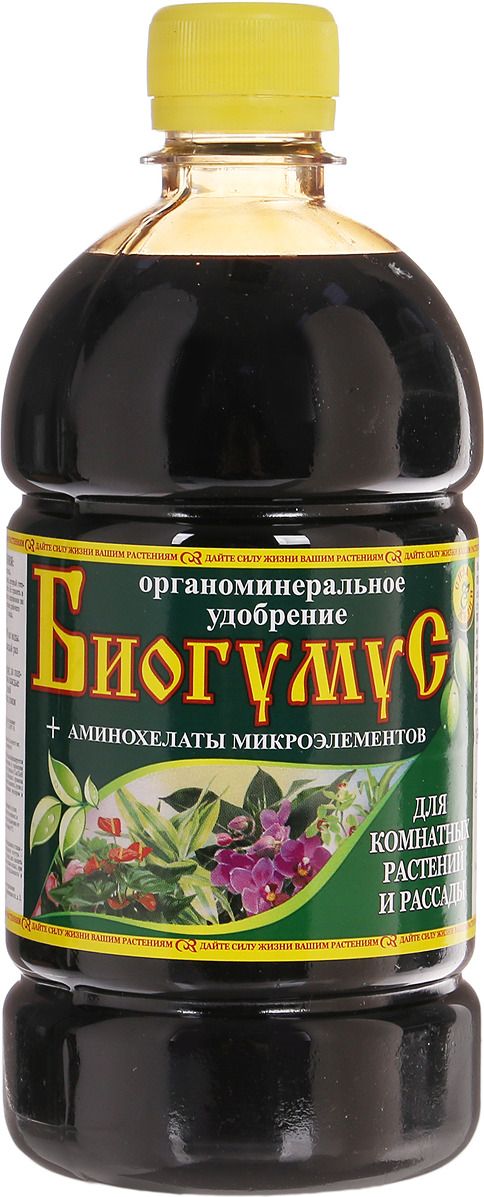

Liquid vermicompost is diluted according to the instructions and the plants are fed after watering
Dry vermicompost can be used as a top dressing for adult plants, scattering 1-2 tablespoons in each pot 1-2 times a month before watering. Liquid vermicompost is diluted according to the instructions and watered on wet soil every 1-2 weeks.
Kiwi top dressing is carried out only during the period of active growth: from spring to late summer. At the end of summer and autumn, fertilizing with vermicompost is stopped, and for successful wintering, you can use twice phosphorus-potassium fertilizers. The first feeding is carried out at the beginning of September, and the second - after 3-4 weeks from the first.
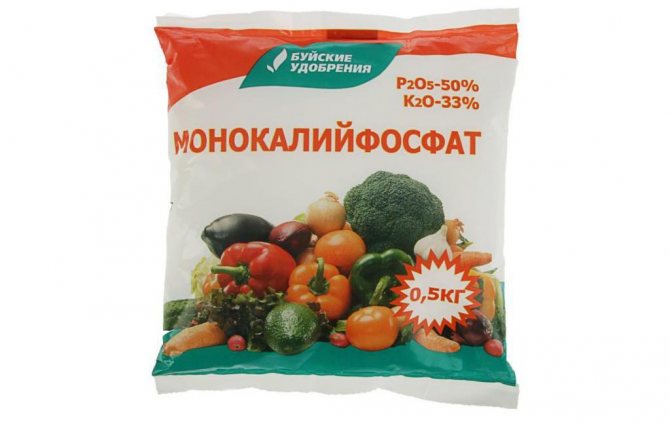

In the fall, before wintering, the plants are watered with phosphorus-potassium fertilizers.
Also, for feeding kiwi during the active growing season, you can use folk remedies: yeast tinctures, herbal infusions, chicken manure infusion (only once in spring after bud break).
When chlorosis appears on the leaves, spraying with any complex mineral fertilizer can be applied.
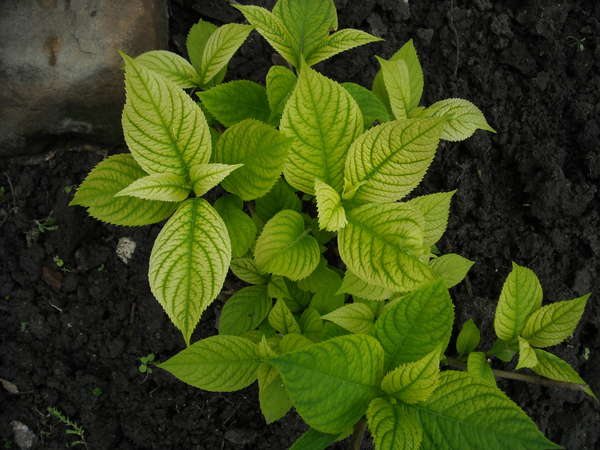

When chlorosis appears on the leaves, you need to sprinkle the plant with a complete mineral fertilizer
The choice of planting material
The first task of any gardener is to decide on the planting material. You can grow your own kiwi vine in one of two ways: by planting a cuttings or by growing seedlings from seeds. Each of them has certain advantages and disadvantages, but in any case, it will turn out to acquire your own kiwi, which will delight at home.
Cuttings
The main advantage of cuttings is their high growth rate (compared to growing from seeds). And the difficulty lies in finding a suitable branch for planting. It is not so easy to find planting material even in the southern regions of the country.
How is the landing made? You need to act like this:
- Cut the resulting branch into small sections. Each of them should have 2-3 (or more) kidneys.
- Next, the cuttings must be kept in water (it should be at room temperature), lowering them to a depth of 4-5 centimeters. Exposure time - until the formation of roots 3-4 centimeters long and an additional 1-2 days.
- After that, you need to make a solution of the root former (the product can be purchased at any specialized store and diluted according to the instructions). Cuttings with the formed root system are lowered into it. Withstand for 1-2 days.
That's all, it remains to plant a stalk with roots in open or closed ground.
Seeds (bones)
Growing kiwi from a seed (seed) is no less difficult, but more time consuming. The main advantage is the ease of acquiring planting material. You can find it in any specialty store. The downside, as mentioned earlier, is the time spent. You will have to wait long enough for the moment when the seeds reach the desired size for planting in the ground. In addition, taking care of sprouts, due to their fragility, is more difficult than for cuttings.
How to germinate seeds? This should be done in a warm place. It is best to use a mini greenhouse or greenhouse (at least a homemade one). The easiest way to make a mini greenhouse is from a bowl, plastic wrap, and a damp cloth. You need to put the seeds in the container of the greenhouse and wait for them to peck. Then the seeds are planted in a special box for seedlings (can be purchased in a specialized store) to a depth of no more than one centimeter. From above, the box must be covered with either a film or a plastic lid.
Periodically, the film or plastic cover must be removed to ventilate the seeds.
Usually, seeds sprout 6-8 days after planting. Further, they should be thinned out. The procedure involves getting rid of weak specimens. Continue growing sprouts until they are at least 10-12 centimeters tall. Then you should transplant each sprout into a separate pot or into open ground.
It is very convenient to remove sprouted seeds from the soil with tweezers. But you need to act carefully so as not to damage the young plant.
You can get planting material directly from the fruit. To do this, proceed as follows:
- Take half of the fruit (prefer ripe ones). Extract the seeds from it (at least about 20 seeds). They should be freed from the pulp. Tweezers will help in this matter. You can also dip the pulp in a glass of water: the bones will separate and float.
- Rinse the seeds with cheesecloth and running water. It is advisable to repeat the rinsing several times, especially if the pulp cannot be removed in any way.
- Once the seeds are clean, place them on a saucer and leave to dry for two to three hours.
- The next stage is germination. To do this, put a piece of cotton wool moistened with hot water in a saucer. Place seeds on top. Set the saucer in a sunny place and wrap with plastic. At night, the film is removed, and in the morning the cotton wool is again moistened with hot water and the greenhouse is re-organized.
The sprouts will appear after seven to ten days. You can transplant them into the ground after the appearance of white roots.
Fruit popularization
Today, the country that is engaged in the mass cultivation of kiwi and has the largest plantations in the world is New Zealand. It is there that the fruits are grown, which occupy most of the world export of this product. The main plantation site is the Bay of Plenty, the North Island, since it is there that the most suitable climatic conditions are for the comfortable existence of actinidia. More than 2,500 special farms are engaged in the cultivation of kiwi in this country, and the supply of their products is distributed throughout the world.
Forage in New Zealand, kiwi production is widespread in other countries, but on a smaller scale, designed exclusively for the domestic market.
Large production facilities are located in:
South Korea also grows kiwi, but in small volumes, about three thousand tons per year, which are intended exclusively for the local population of the country. As for the cultivation of kiwi in America, this country cannot boast of much success.
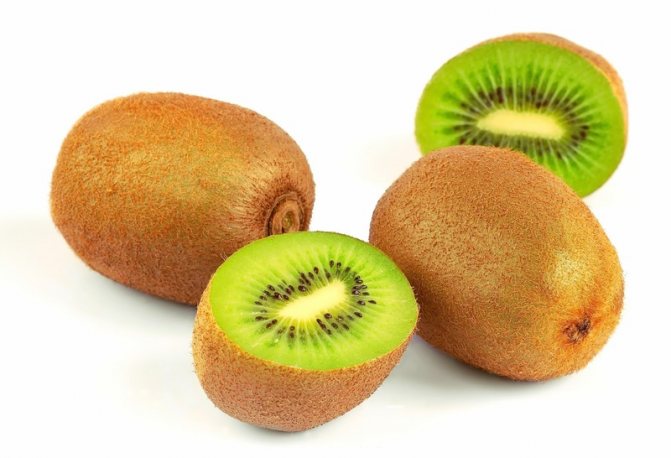

Despite the unfavorable climate for actinidia, many American farms expressed a desire to grow this fruit, and not only for domestic distribution, but also for mass export. However, all attempts ended in bankruptcy of farmers, as they were unable to create conditions similar to how kiwi grows in nature. The only states whose climate is relatively suitable for this plant are California and Hawaii.
Read also Glass veranda attached to the house photo
How to choose
In order to get the most out of kiwi, you need to learn how to choose it correctly. When buying, pay attention to the following indicators:
- bright fruity aroma;
- the skin should be smooth and firm;
- ripe berry should be soft to the touch;
- wrinkled peel indicates a loss of moisture and most nutrients;
- the peel should be free of spots and cracks.
After bringing the kiwi home, put it in the refrigerator. There he can lie for up to 4 weeks. If you purchased an unripe fruit, put it in a sunny place and after a couple of days you will have a ripe, healthy berry.
Pests and diseases
Kiwi is practically not affected by pests, diseases bypass it, and a deterioration in appearance is most often provoked by the gardener himself - due to improper care. Most often, the leaves droop due to rare watering, and if the soil is wet, but the leaves hang with a rag, it means, on the contrary, they are overmoistened. To remedy this situation, inspect the drain holes to see if they are clogged. Gently loosen the top layer of the soil, and if the soil is very dense, use a knitting needle to pierce the soil to the bottom in several places to let air in to the roots.
In the dry air of an apartment, kiwi can be struck by a spider mite, so preventive spraying is needed, especially in summer, and if a pest is found, treatment with Fitoverm.
Preparing seeds and planting kiwi
It is not difficult to grow kiwi at home from seeds. The seeds of the plant are removed from the fruit, washed under running water through a fine strainer, and dried on a paper towel. The seeds do not need either stratification or processing with potassium permanganate. You can plant them almost immediately. It is important to choose the right soil and prepare the greenhouse.
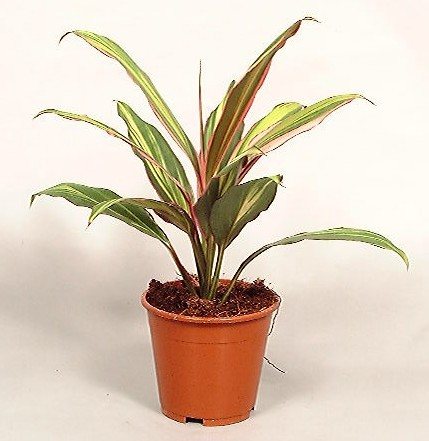

Kiwi grows best in a substrate with the addition of peat, sand, vermiculite and organic fertilizers. The substrate should be nutritious and loose. Heavy soil is mixed with sand. The soil is well moistened and seeds are sown.For even distribution of seeds, they can be mixed with sand and spread over the soil surface. Seeds can be lightly sprinkled with soil, sprinkled with a spray bottle and covered with foil. The box with seeds is periodically ventilated, trying to prevent condensation. Additional watering is usually not required, as a last resort, you can spray the substrate from a spray bottle. Seeds germinate well at 23-25 ° C.
When the first shoots appear, the film is removed more often and then completely removed. Transplanting seedlings is carried out after the appearance of 2-3 pairs of adult leaves. A pot that is too large for a plant is not chosen. Kiwi is developing rapidly, so it will have to be transplanted several times. In addition, you should take care of the support, as the kiwi is considered a climbing plant and needs a garter.
Kiwi needs good lighting, therefore, the plant is supplemented in autumn and winter. With a lack of light, the plant begins to wilt and the likelihood of fruiting decreases sharply. Like any representative of the flora, direct scorching sun is contraindicated, but it will be better if the plant spends extra time in bright light than in the shade. An adult plant is not afraid of excessive heat and direct sunlight, but it is better for young seedlings to create more comfortable conditions, otherwise they may stop growing.
Loading ...
Plant characteristics and features
The kiwi tree looks like most climbing plants, it can grow up to eight in length and a bush up to five meters in width. The vine braids all plants within the radius of the width of its bush.
The diameter of the leaves of the shrub is on average 20-23 centimeters, they have an oval or rounded shape, the texture of the leaf is leathery. Young leaves and shoots have characteristic red hairs. Mature and hardened leaves are filled with a dark green color, have a smooth upper side, on the lower part of mature foliage there is white fluff and light streaks.
Kiwi blooms in large white flowers with a cream shade, ranging in size from three to five centimeters. Flowers bloom from the first half of May to mid-June, depending on the climate of the region where the plantation is located, the flowering of the bush lasts about two weeks. Kiwi is a dioecious plant, meaning that male and female flowers grow on different plants. For the plantation to bear fruit, you need to grow different-sex bushes next to each other.
The kiwi fruit itself grows up to five centimeters long., can have an oval or ovoid shape and a reddish-brown skin, covered with a hard nap. The inside of the fruit is preferably bright green, but sometimes the flesh can have a yellow color, the core of the fruit is light, light streaks extend from it along the entire radius. Between these light streaks, the presence of dark purple or black seeds is characteristic, which are practically not felt during meals.
Reproduction methods
When growing kiwi, seeds and cuttings are used. For cultivation by the seed method described above, it is necessary to prepare the soil from a nutrient substrate mixed with sand. However, fruits obtained from seeds can be strikingly different from the parent plant, losing varietal characteristics.
The vegetative method involves the use of green cuttings harvested during the summer pruning of the plant. Cuttings with several buds are suitable for cutting. For the lower cut, an angle of 45 degrees is observed, while the upper cut should be even and 10mm above the kidney.
Note: a fogging installation should be provided in the greenhouse.
Next, the cuttings are placed in water, covered with a damp cloth and left for a day. To root the seedlings, peat soil is harvested, with a layer of 30 cm. The cuttings are rooted to a depth of 3 cm, at a distance of 7 cm from each other. Strictly observe the level of humidity (at least 95%) and soil temperature (at least 3 ° C).
Growing problems:
- Kiwi leaves droop, partially fall off, lose their tone with a lack of moisture in the soil. After abundant watering, the plant quickly recovers.
- The stems become thinner, the foliage turns pale and shredded, the kiwi becomes bald due to lack of lighting.
- The leaves become smaller, acquire a yellow color, the plant loses its tone, the petioles of all leaves turn red with a lack of nitrogen in the soil, nitrogen fertilization is necessary.
- Kiwi leaves turn brown, dry and crumble due to lack of potassium in the soil.
- A brown spot on the foliage indicates a burn from direct sunlight.
- Shredding of leaves, darkening with phosphorus deficiency.
- Wet spots at the base of the shoots indicate an excess of moisture in the soil combined with a cool content.
Views: 273
Beauty berry
If you hold back and don't eat the juicy kiwi, it can be used for masks. The fruit is incredibly beneficial to the skin of the face. Numerous vitamins and microelements in its composition improve blood circulation in cells, promote skin healing, and enrich it with oxygen.
Kiwi nourishes and tightens the skin, makes it elastic, firm. After such masks, the face becomes lighter and healthier. When combined with other ingredients, kiwi is suitable for all skin types. For problem skin, the berry is used together with poppy seeds. For oily, mix with lemon, horseradish or clay.
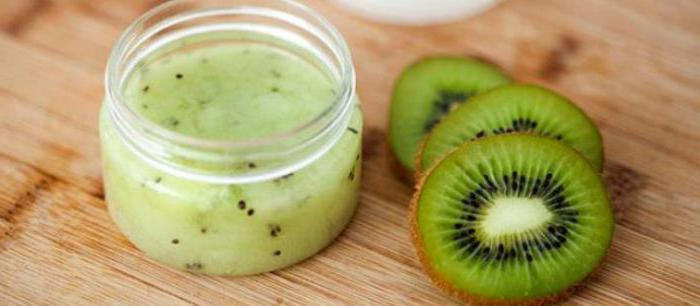

The pulp of the fruit is also used for sensitive skin types, although you should be careful here. The saturated juice can be irritating. Before making various manipulations with kiwi, it is worth checking how the body will react to it. To do this, you can apply a little of the mixture to a small area of your skin.
Interesting Facts
Due to the large size of the berries, many people mistakenly call kiwi a fruit. There are other interesting information about an exotic plant:
- In ancient times, the Chinese rulers used the kiwi fruit as an aphrodisiac.
- The tree is not very susceptible to disease, and insects practically do not eat it.
- Because of its shaggy skin, kiwi is called "monkey peach" in China.
- A wild plant is extremely rare. The size of its fruit reaches only 35 grams, cultivated kiwi can grow up to 110.
- The plant lives on average for 40 years.
- This berry contains more vitamin C than citrus fruits, but less than red bell peppers and parsley.
- Kiwi peel is good too. It is believed to be high in fiber and antioxidant properties. True, it can have a laxative effect, so you need to be careful.

